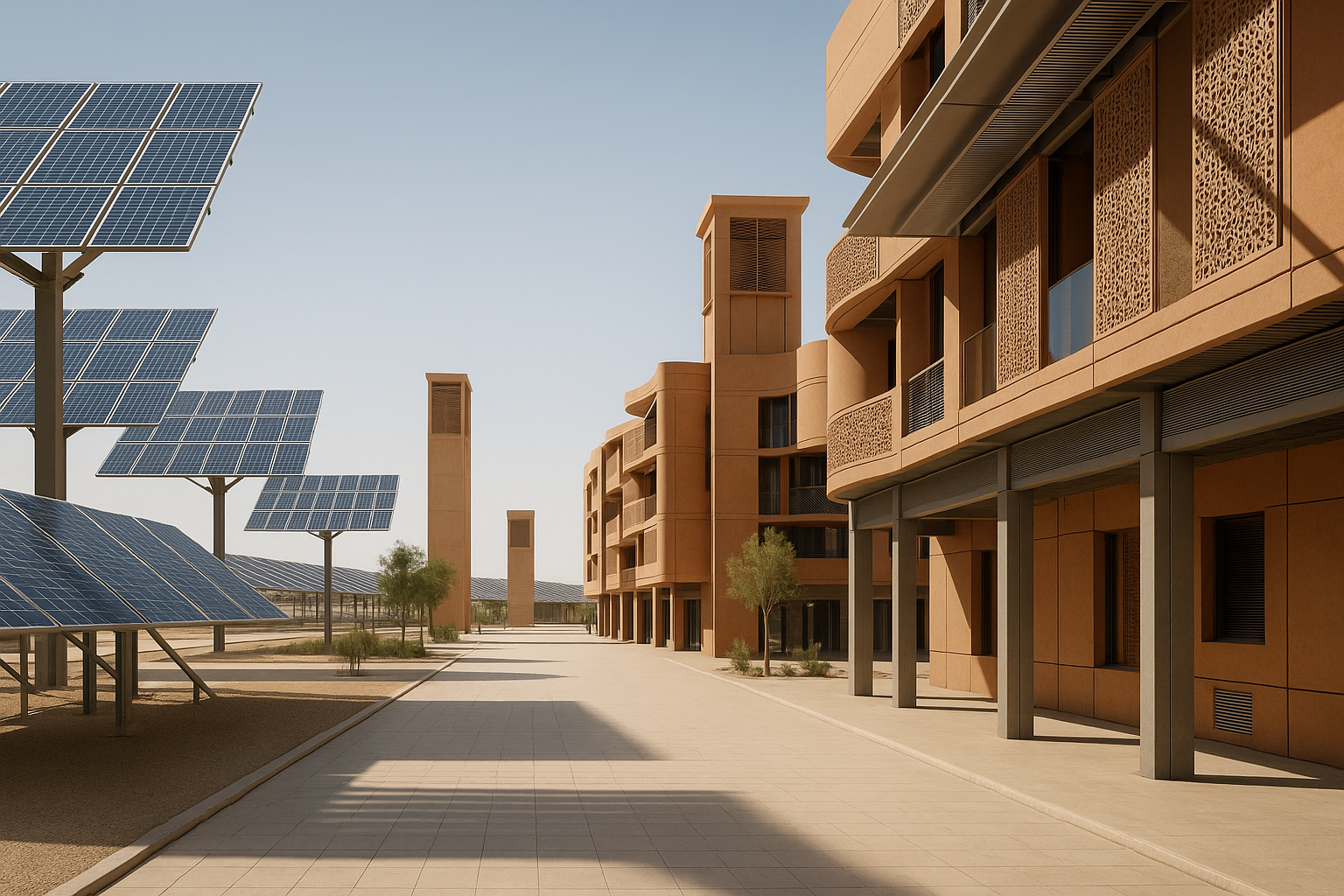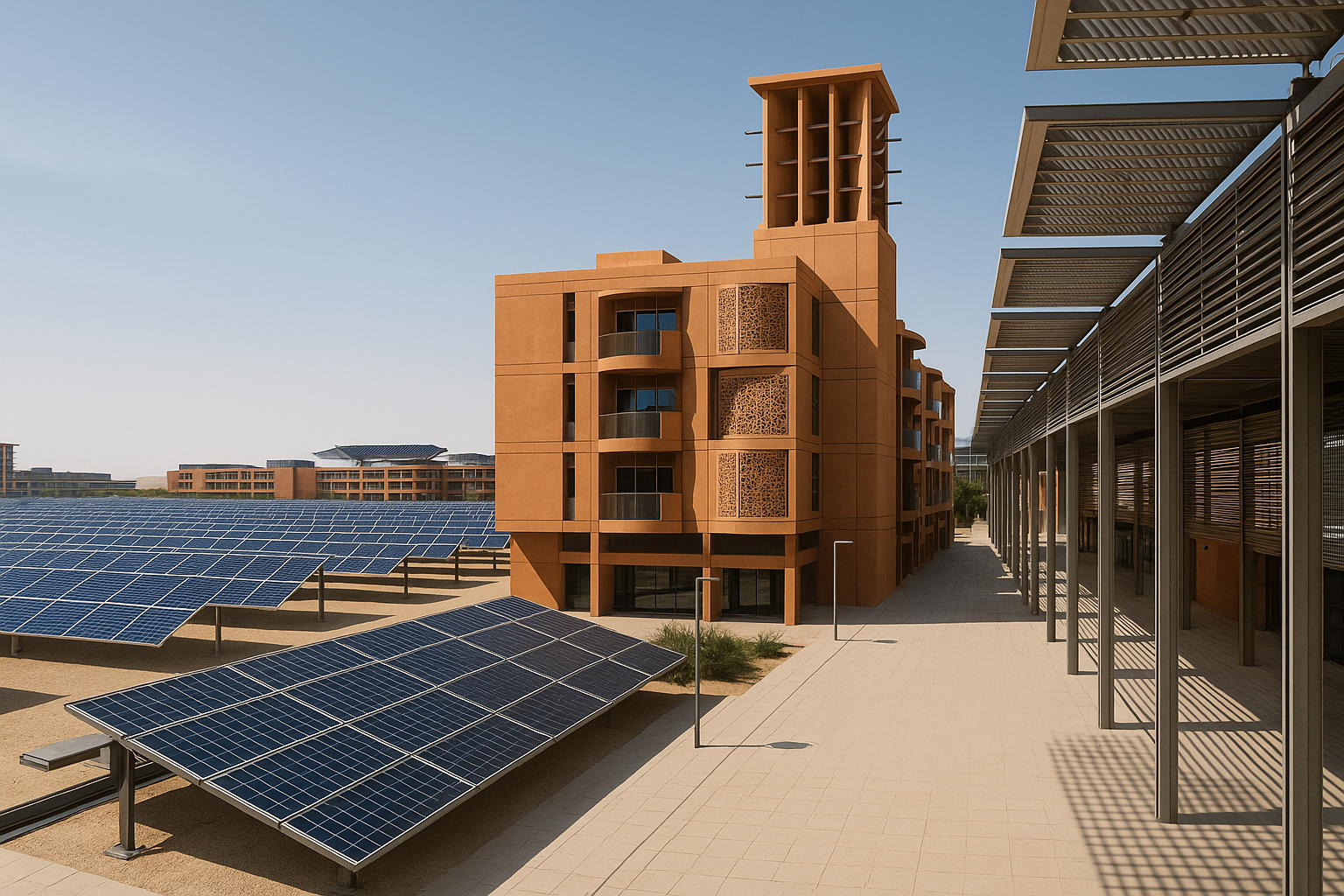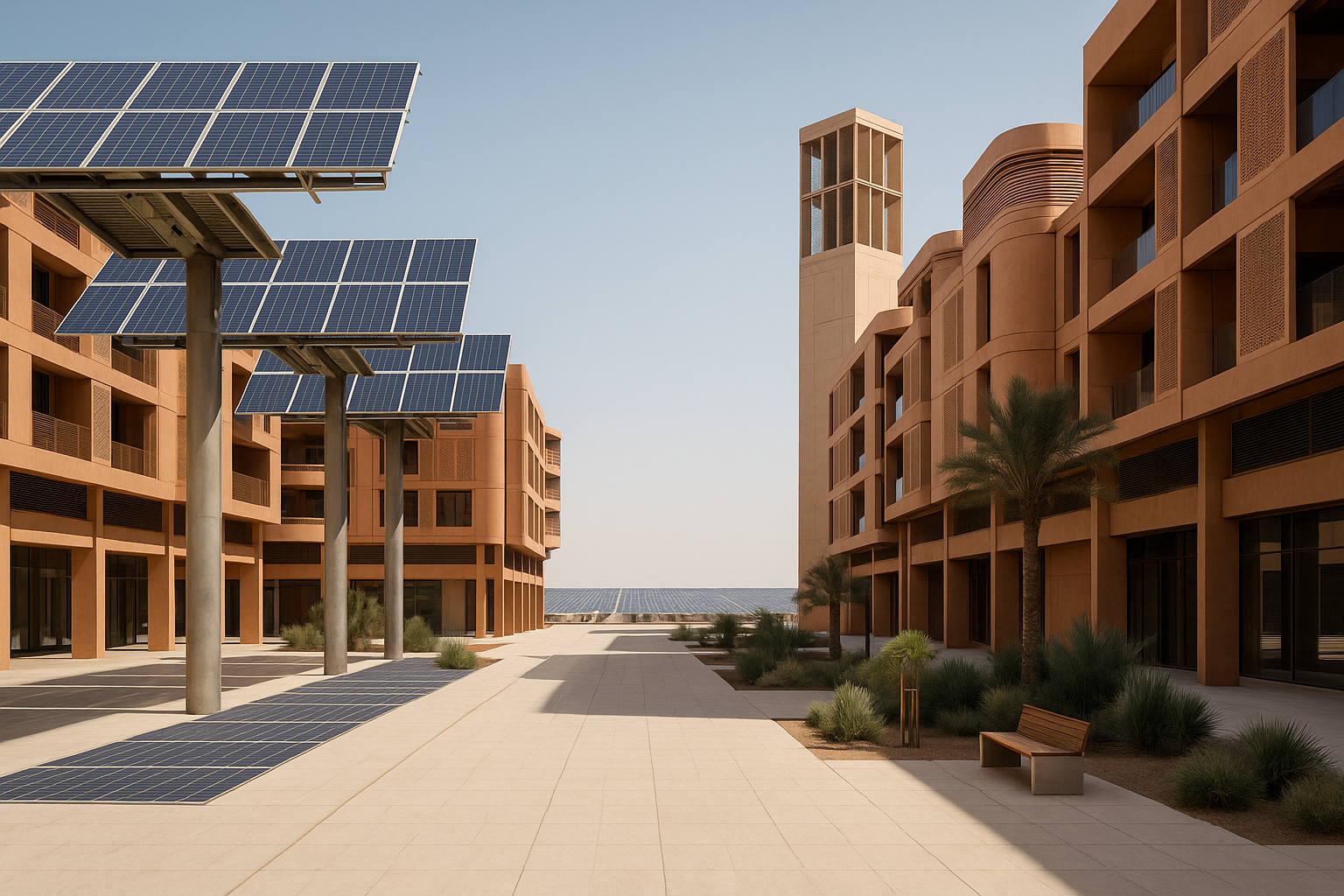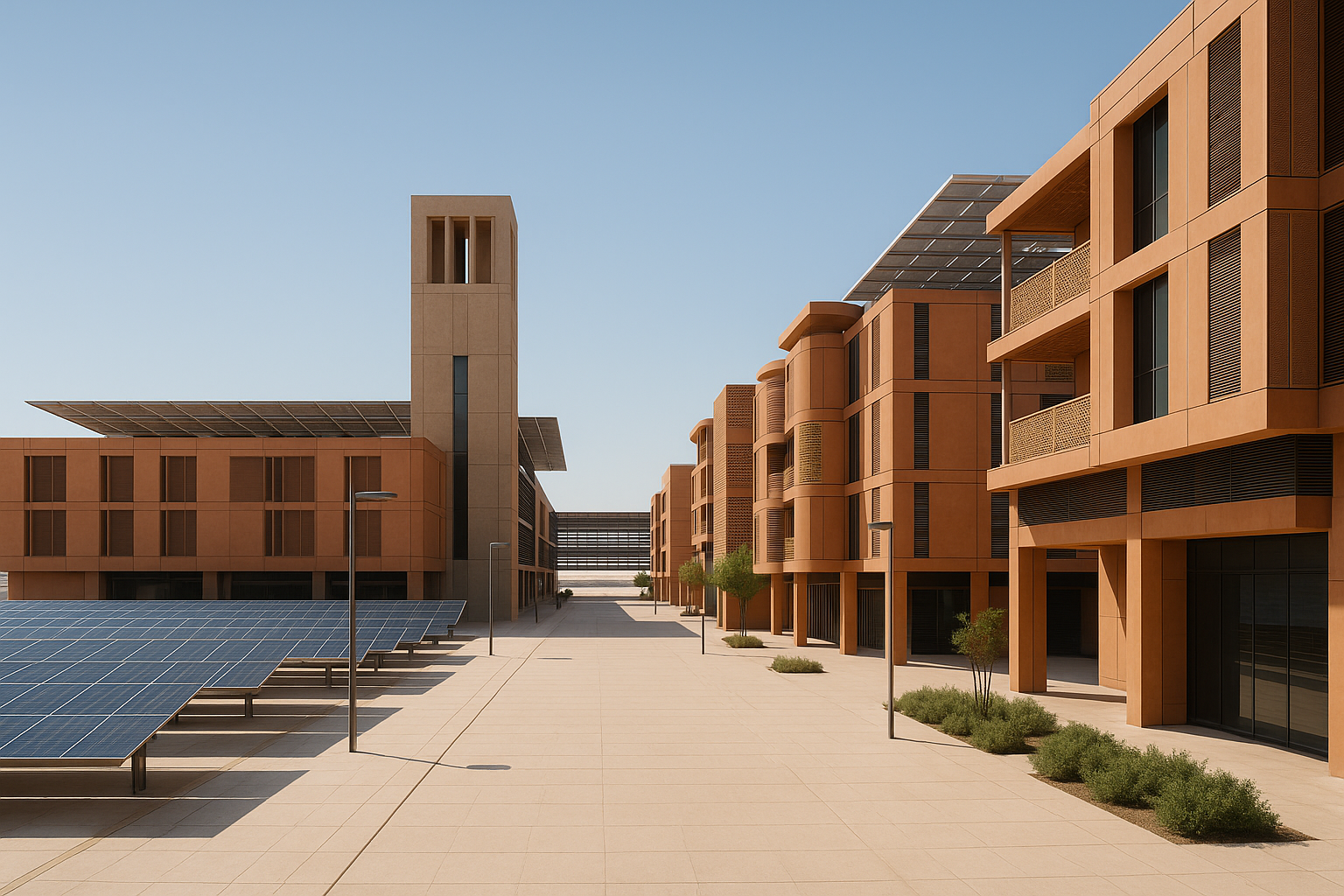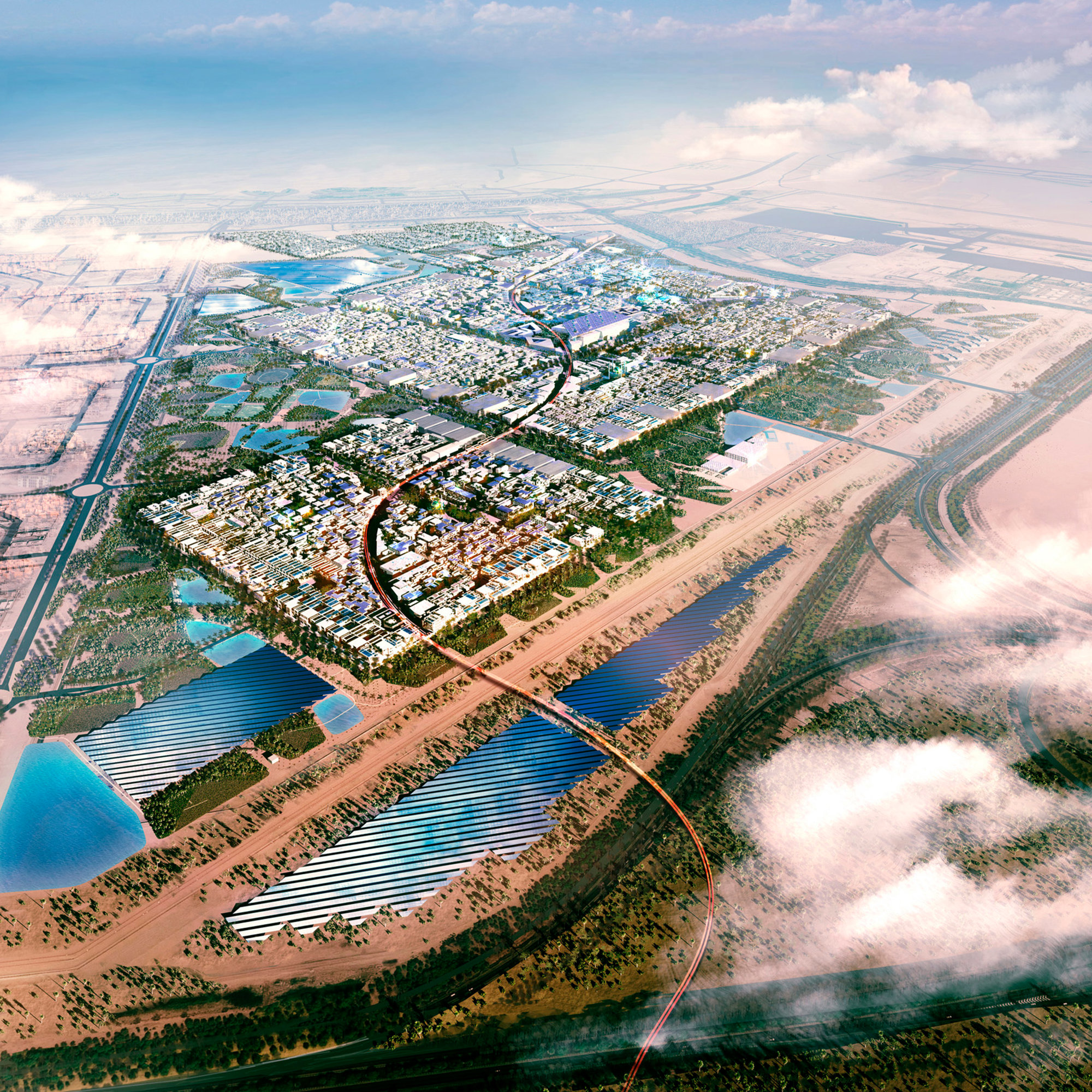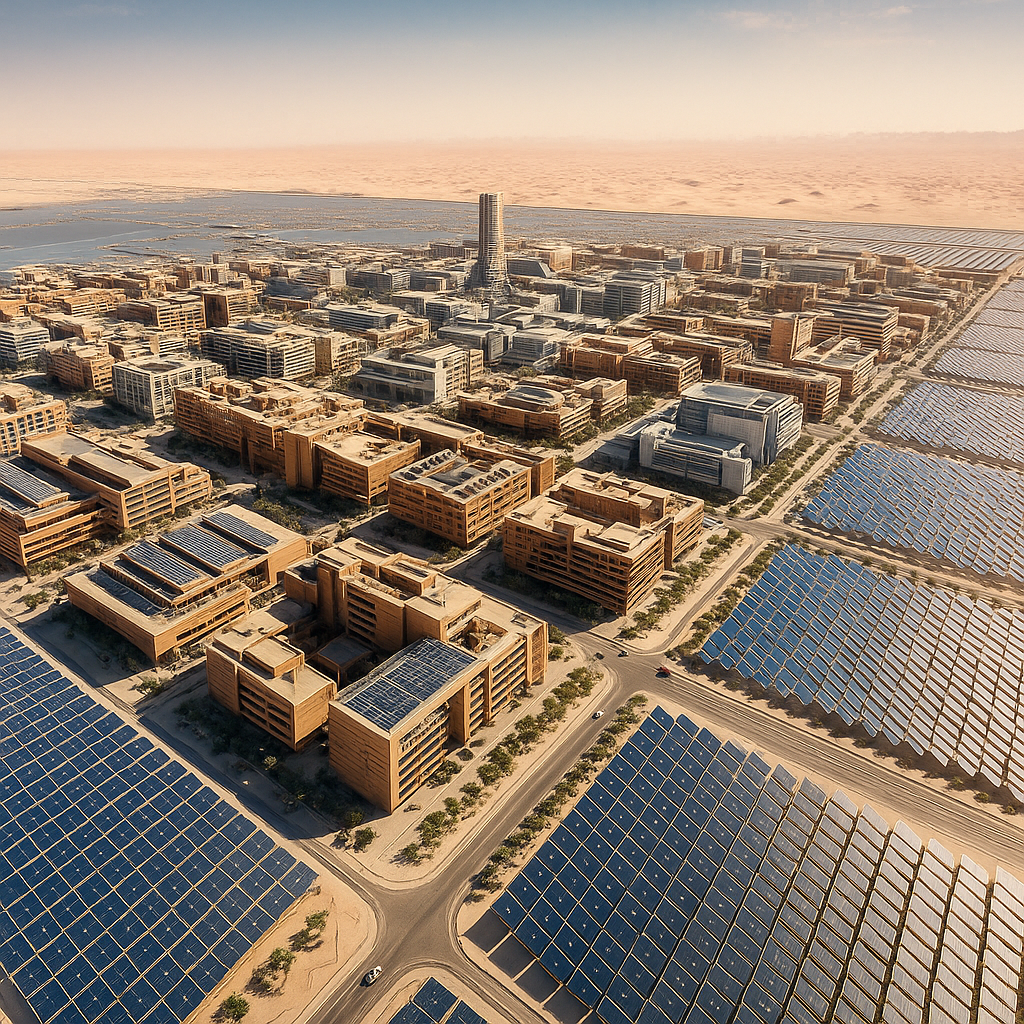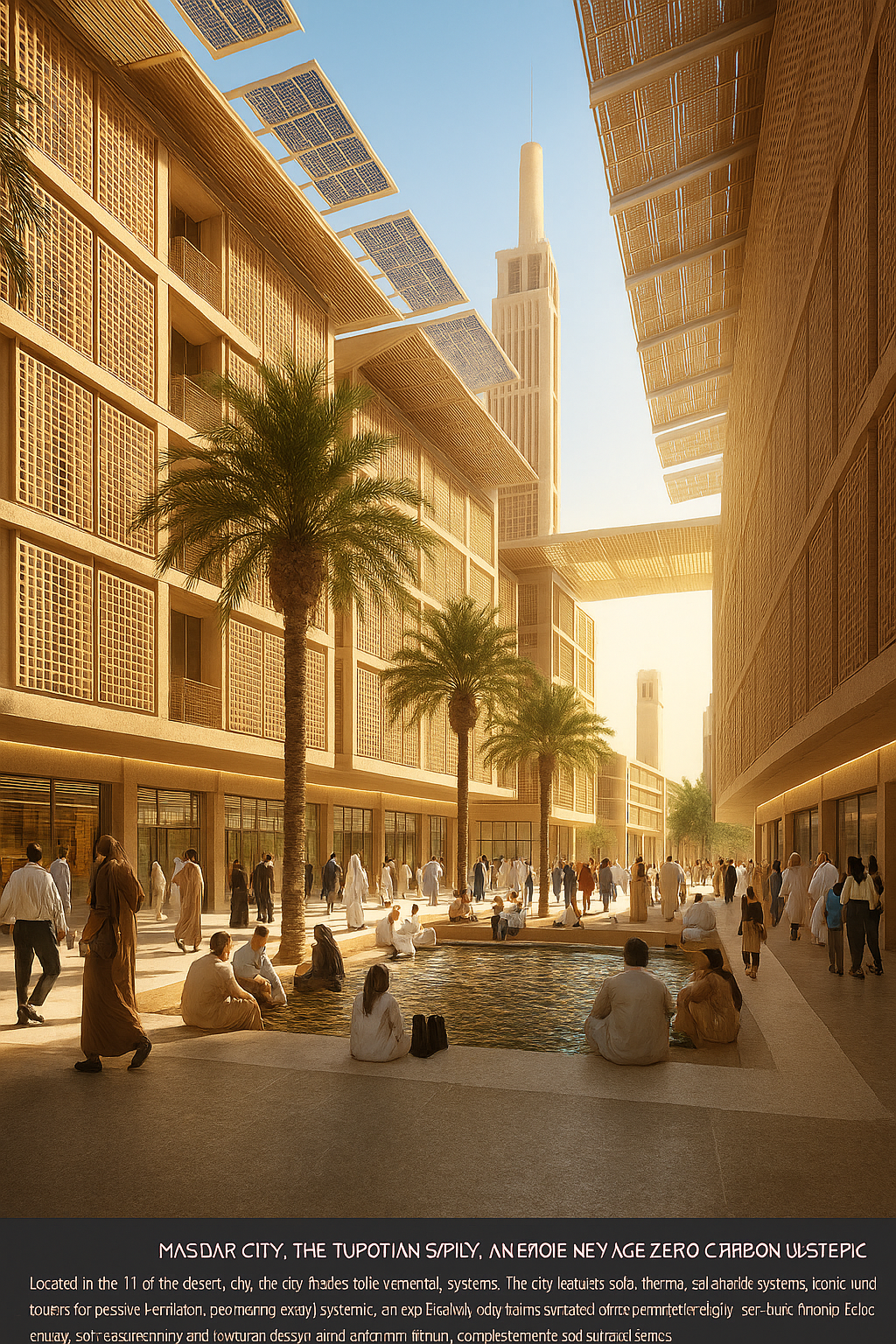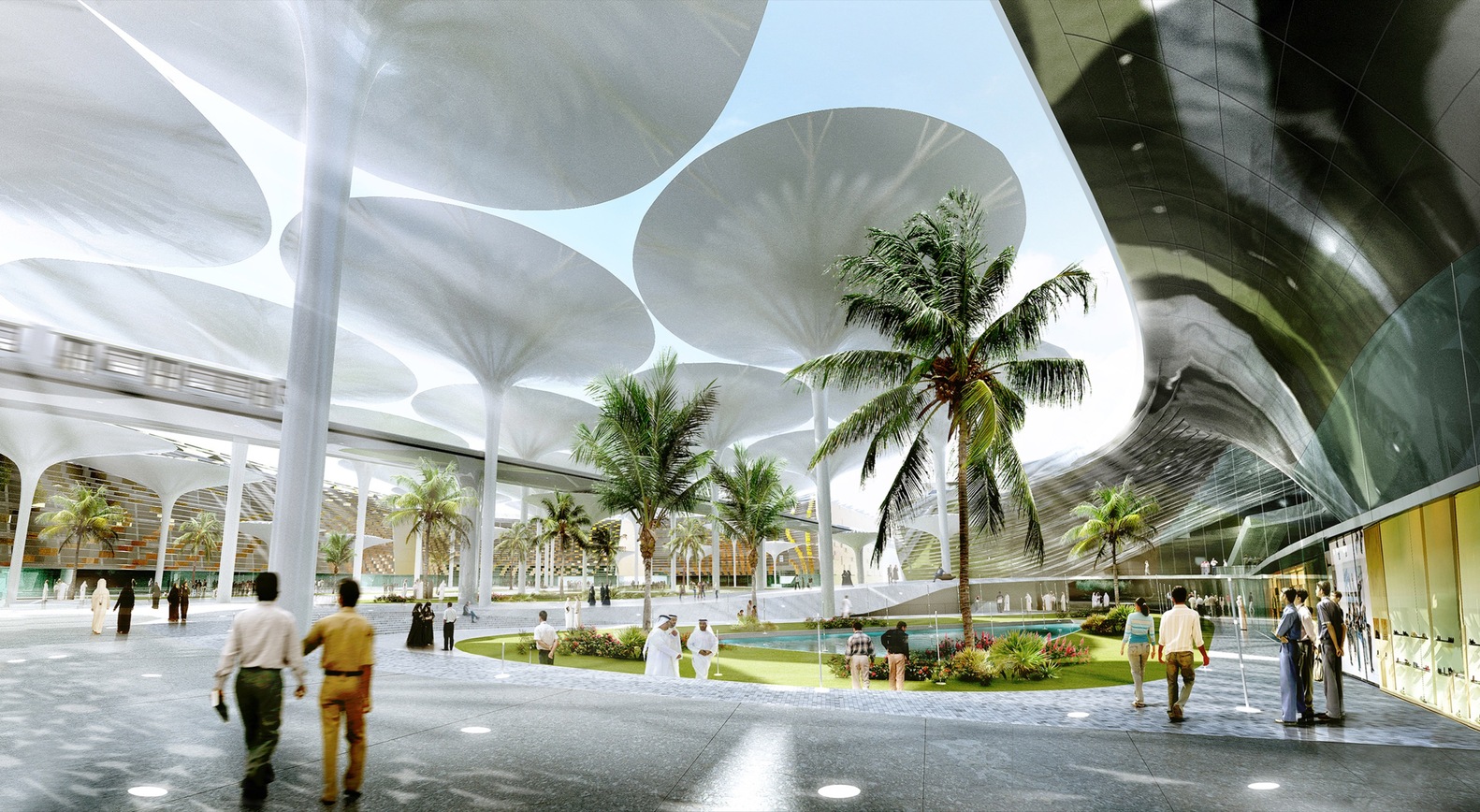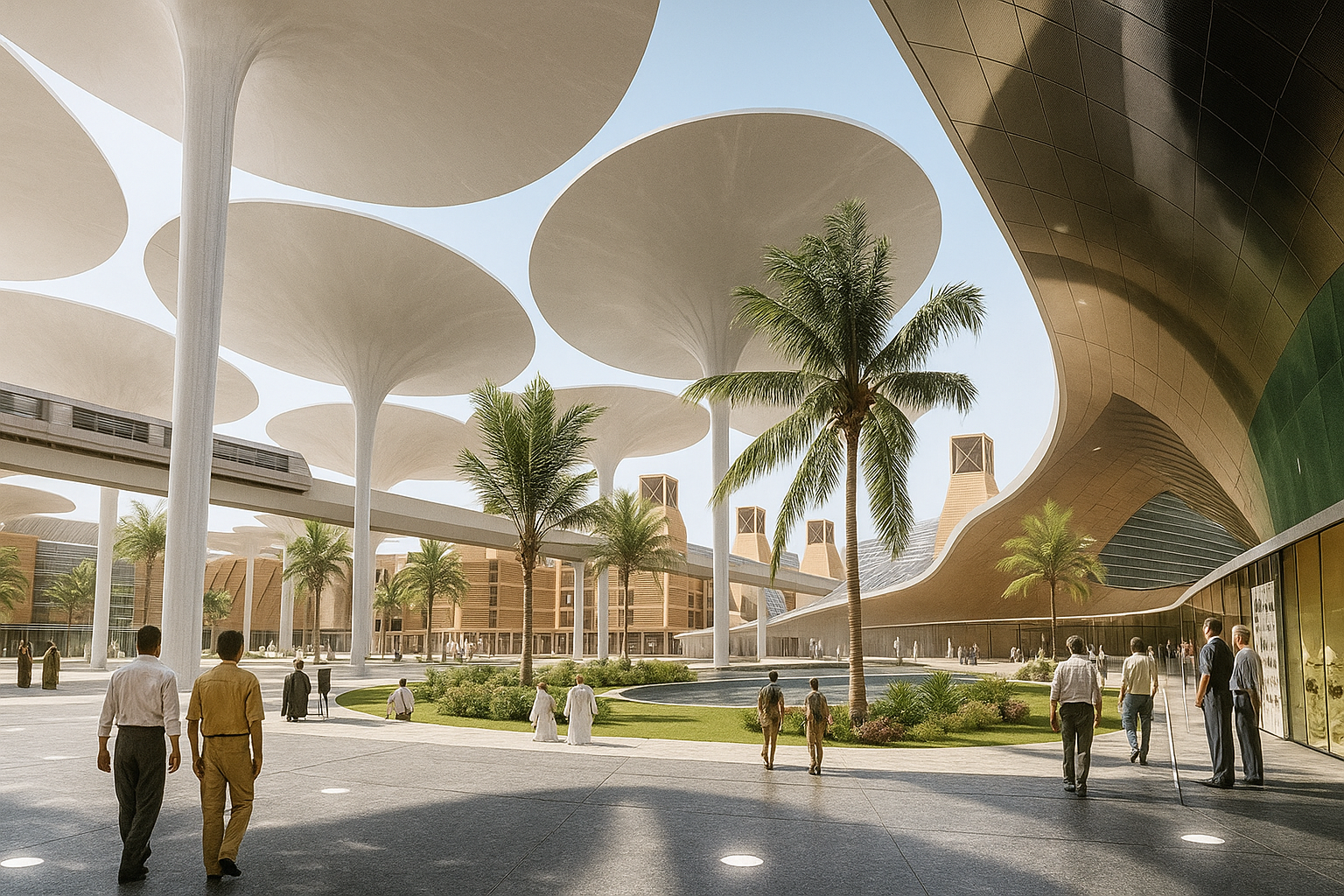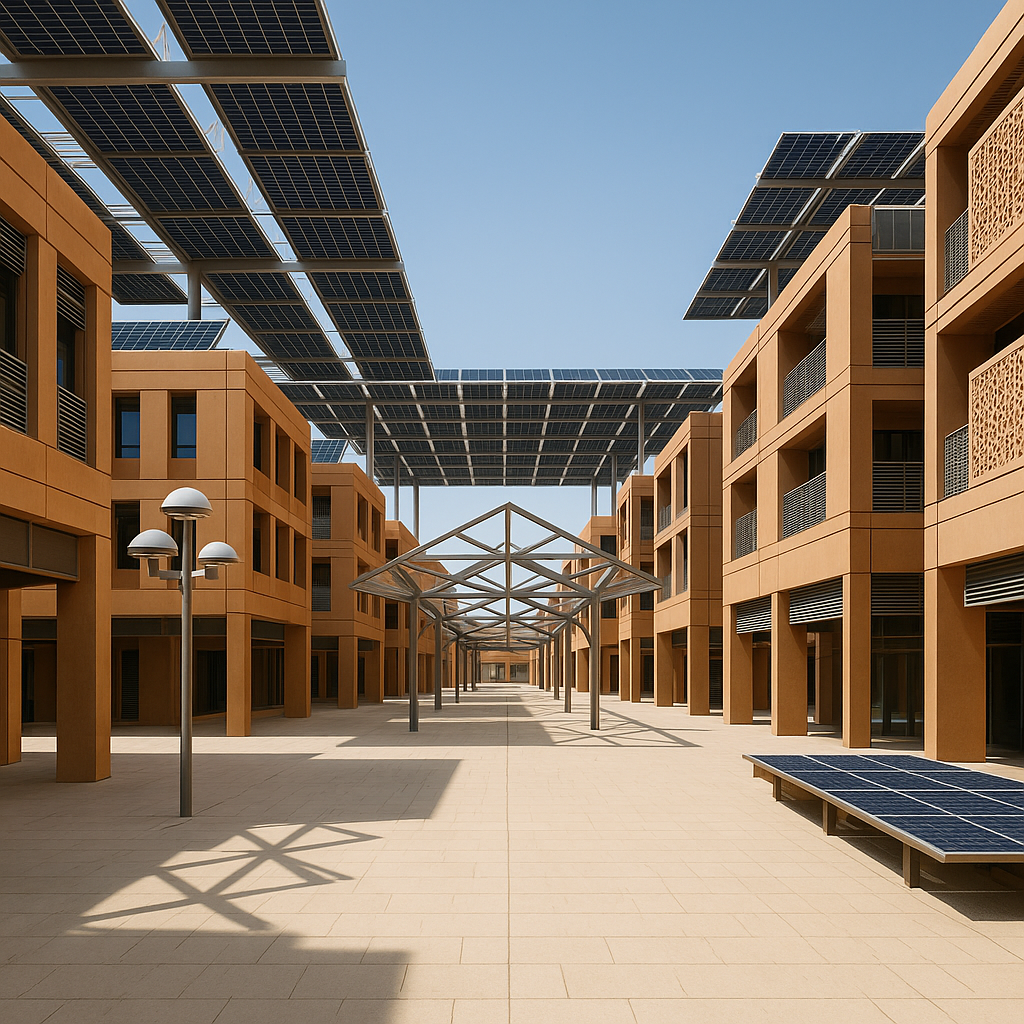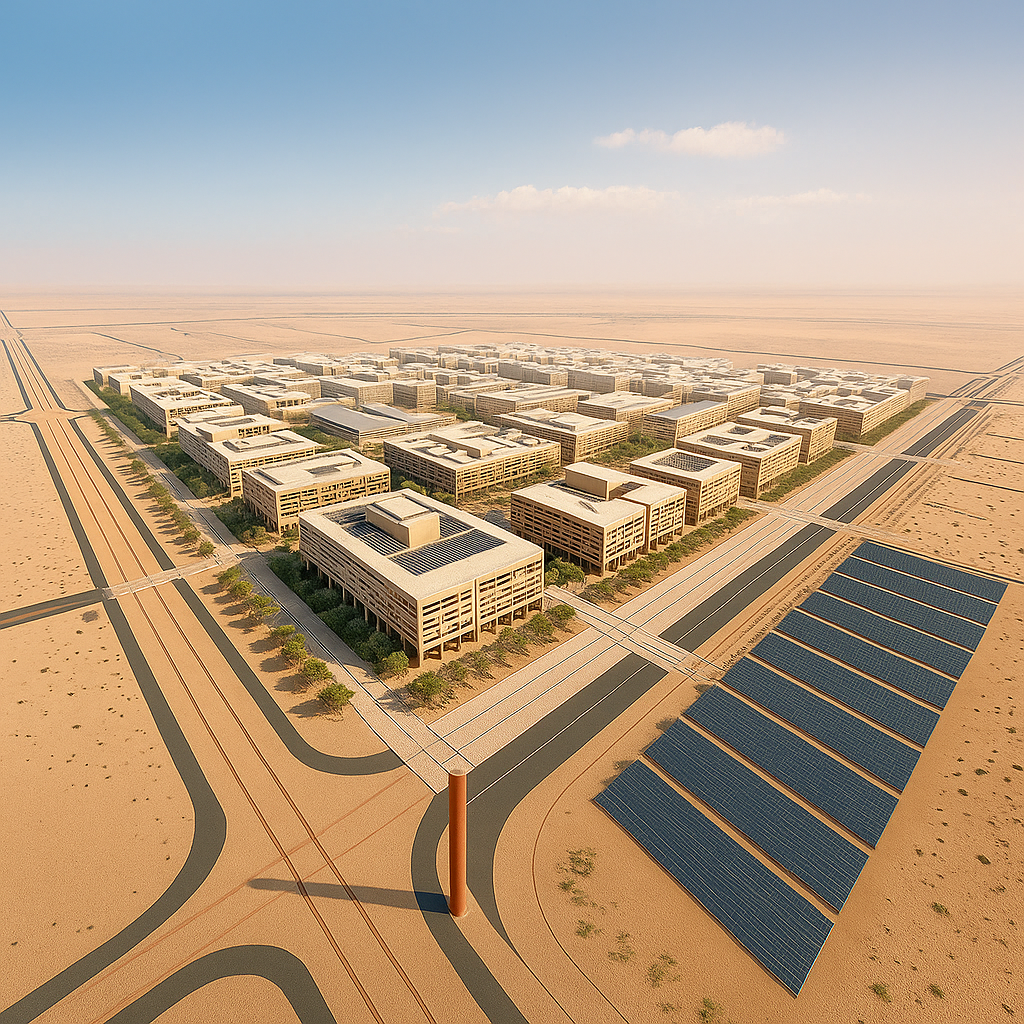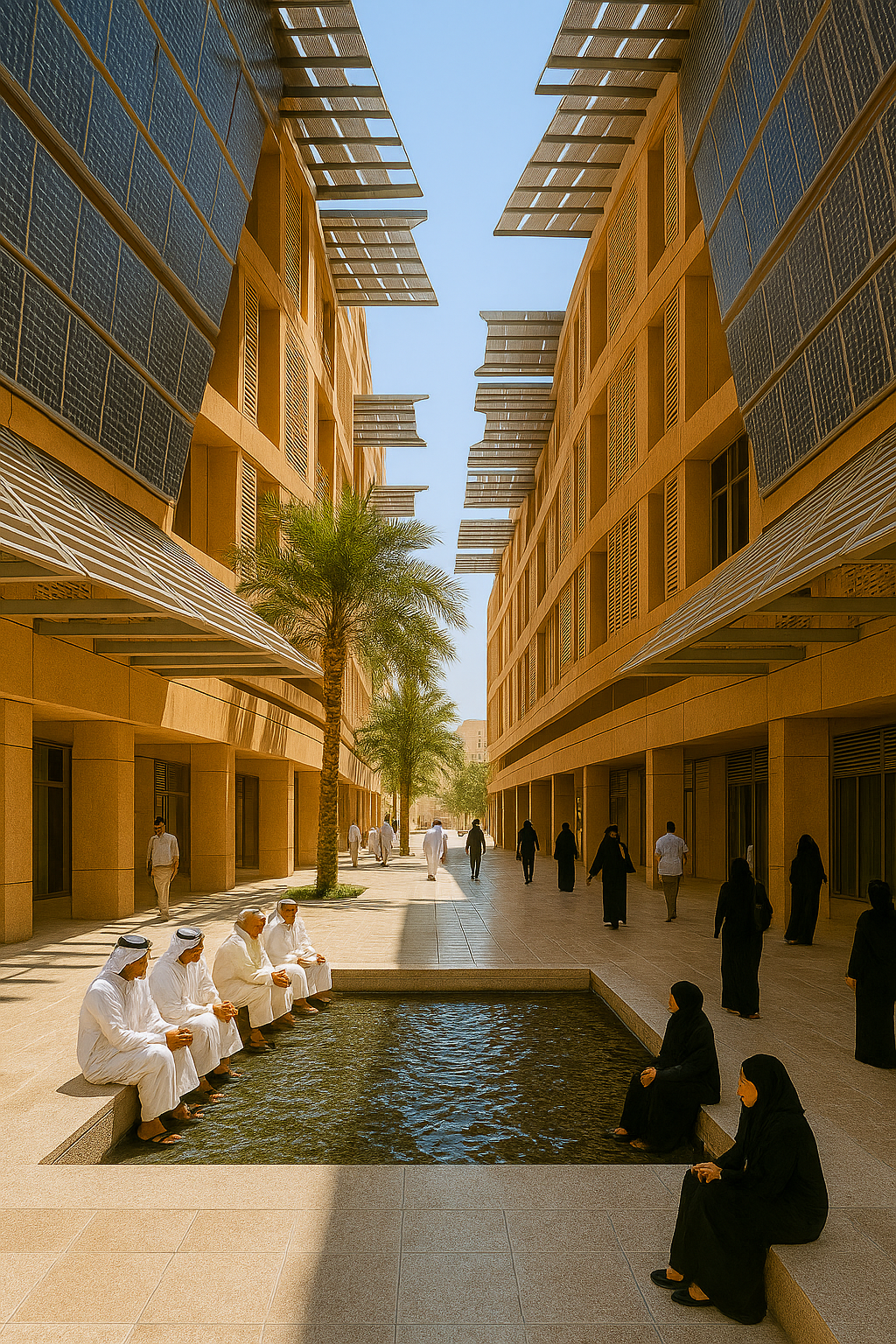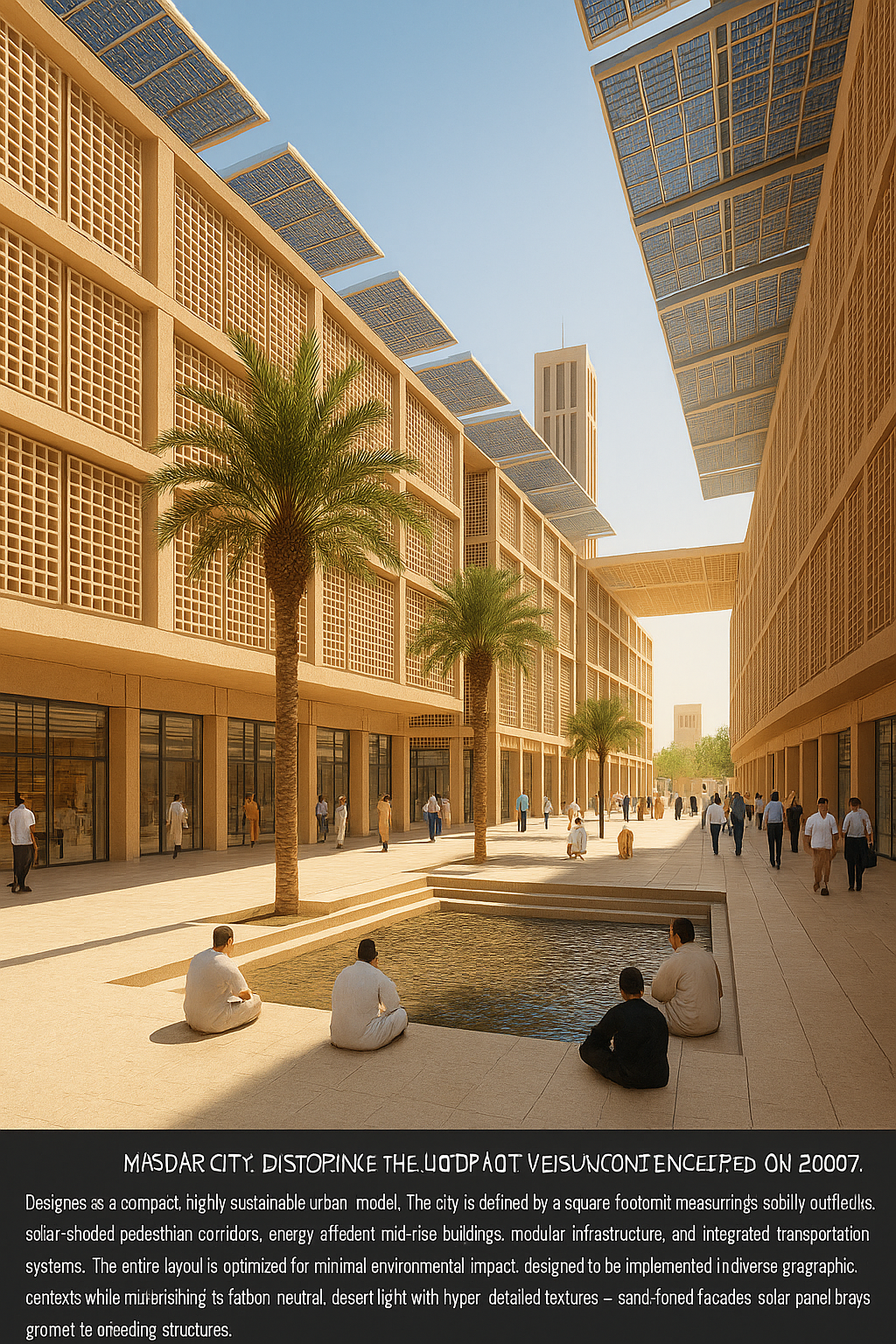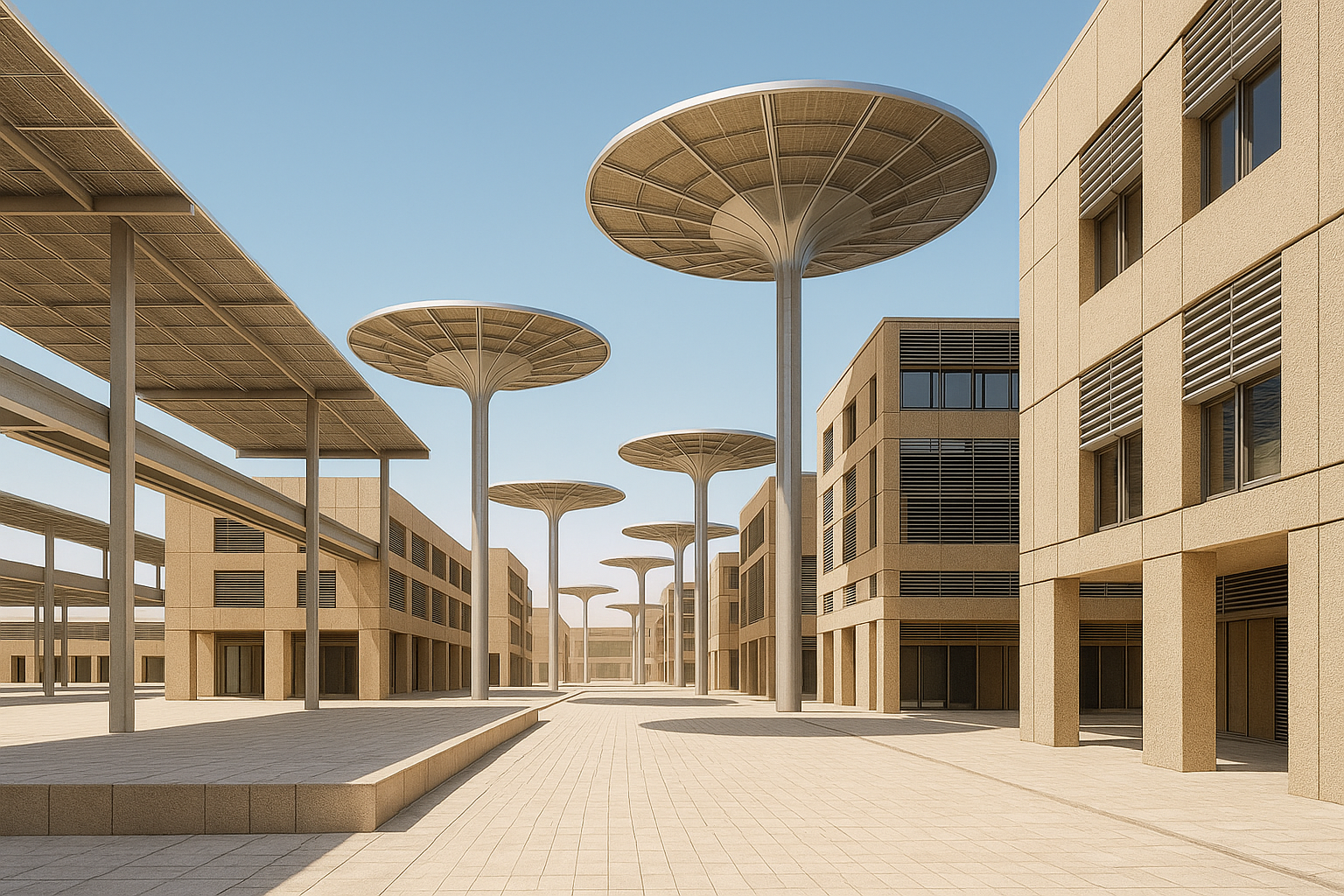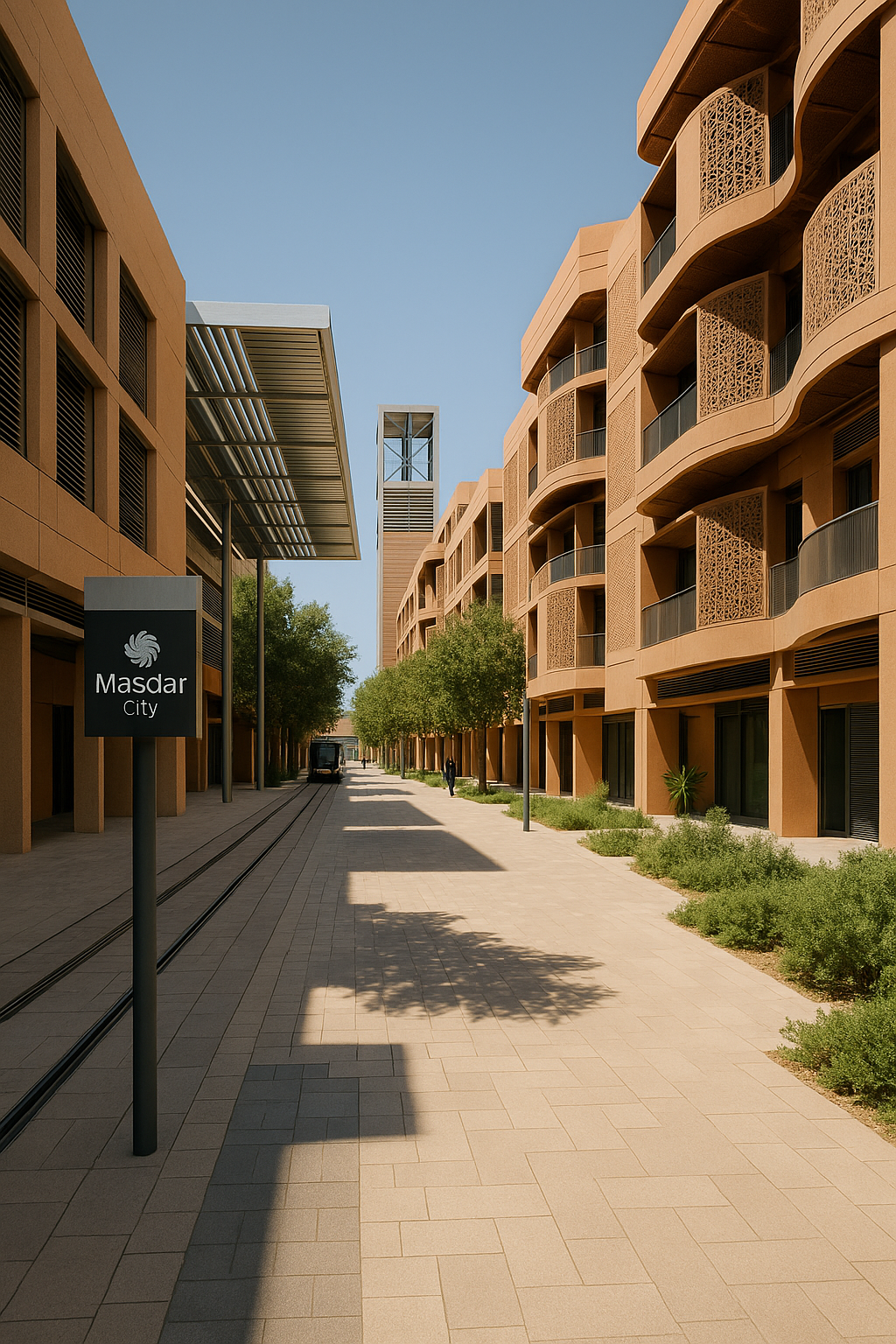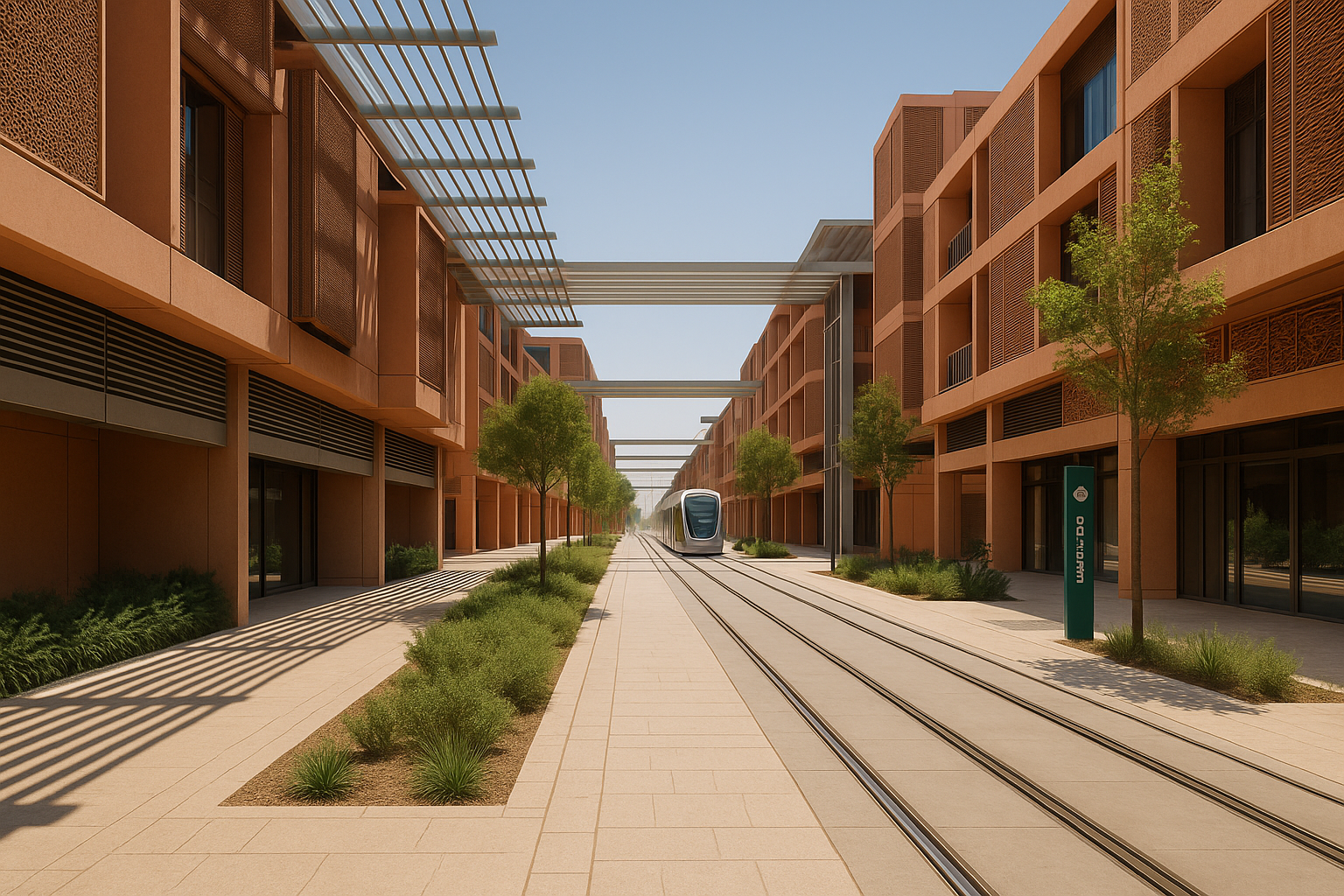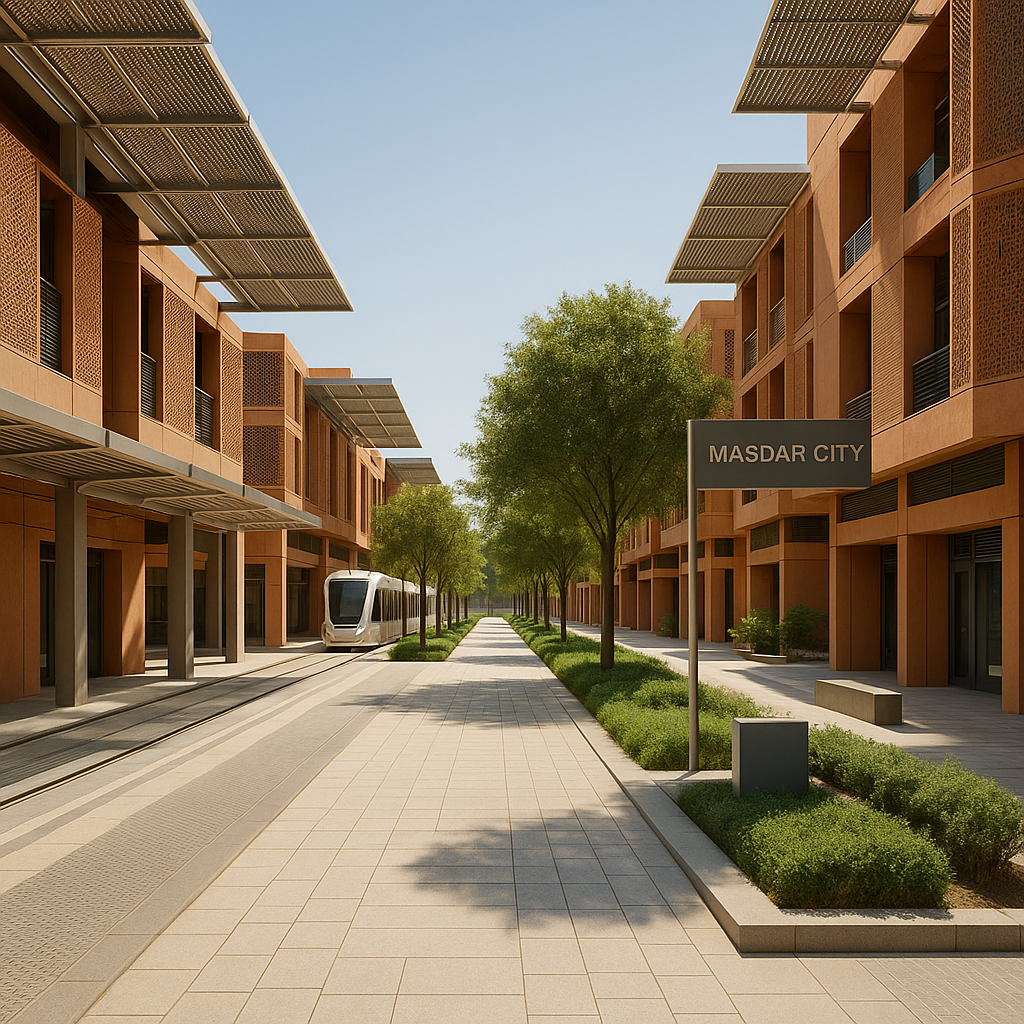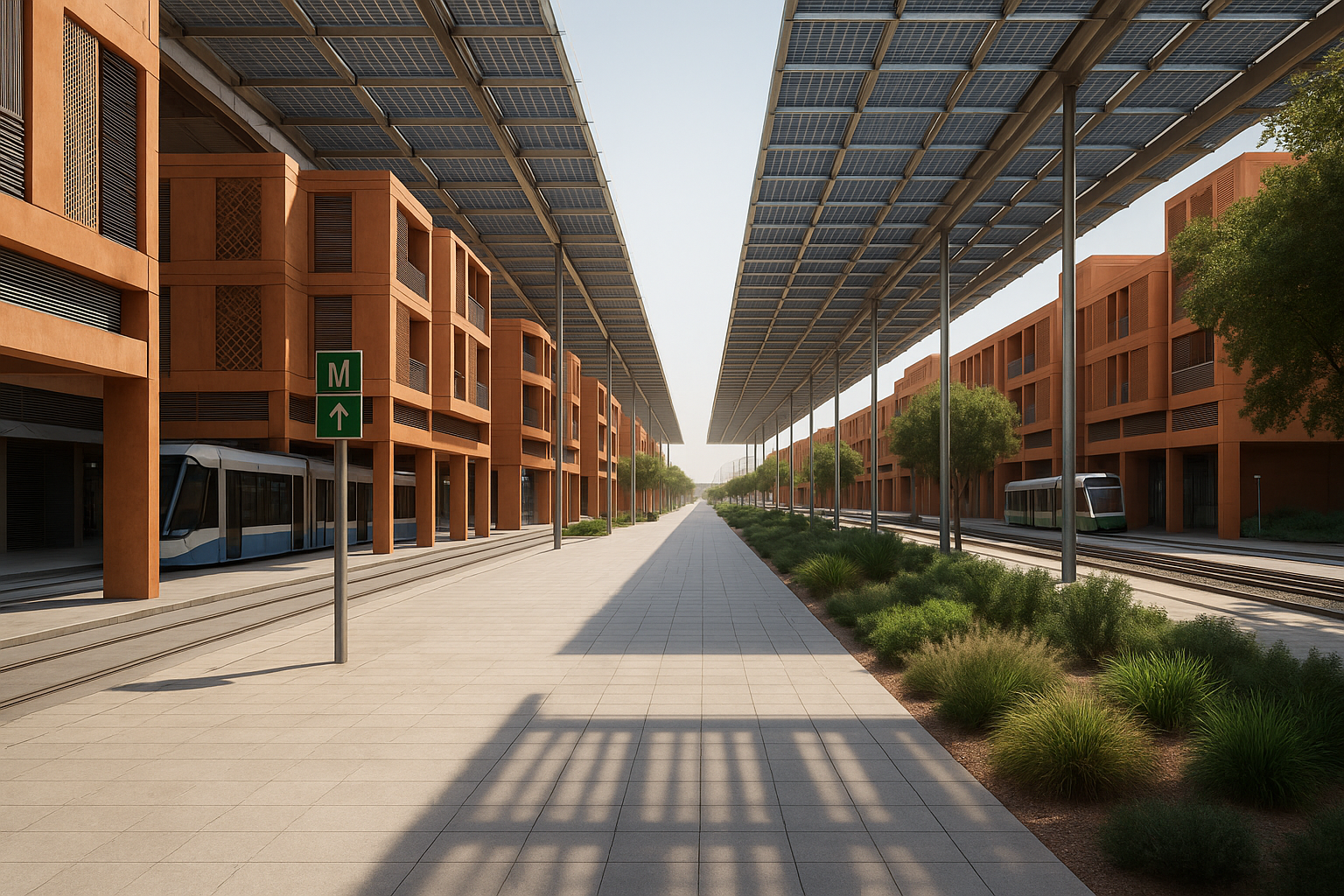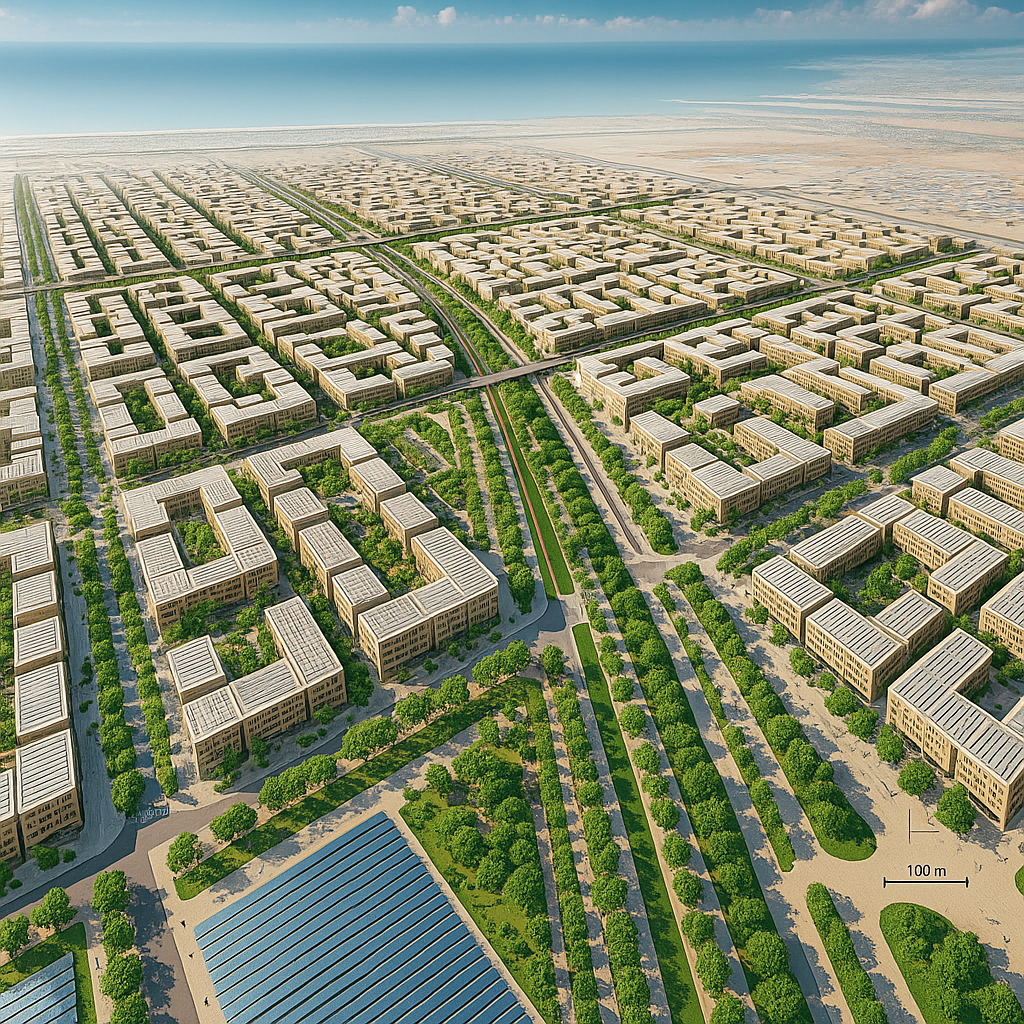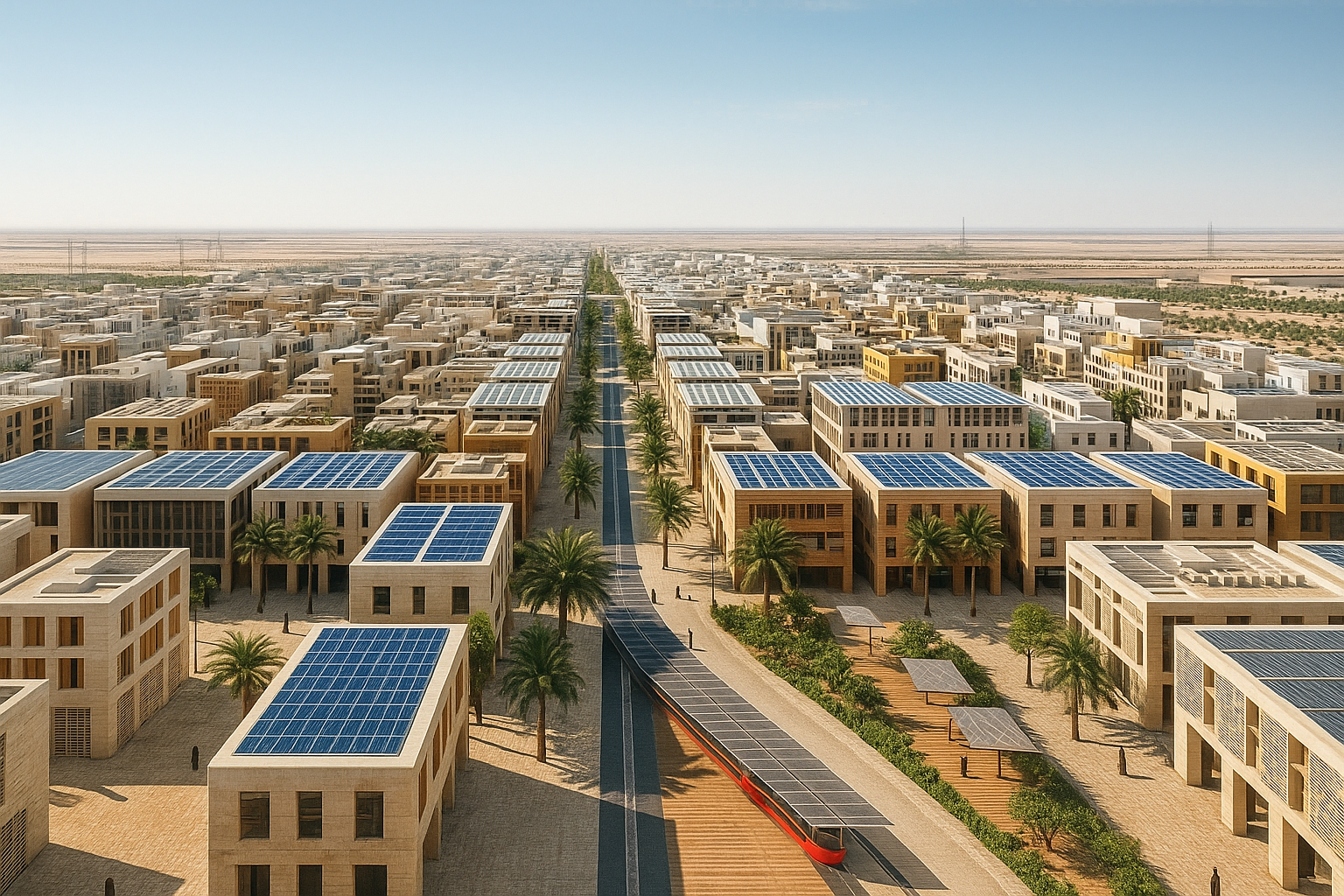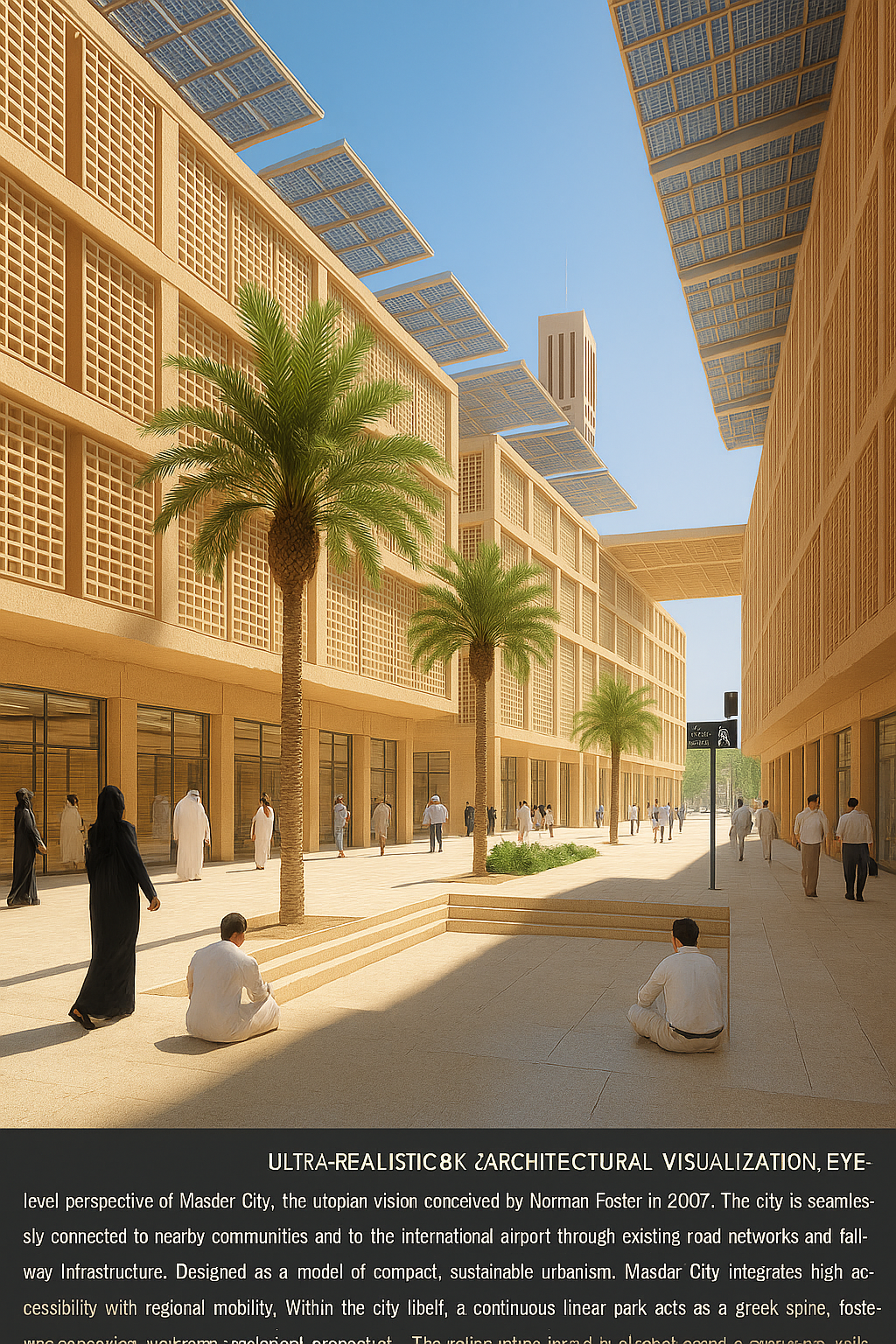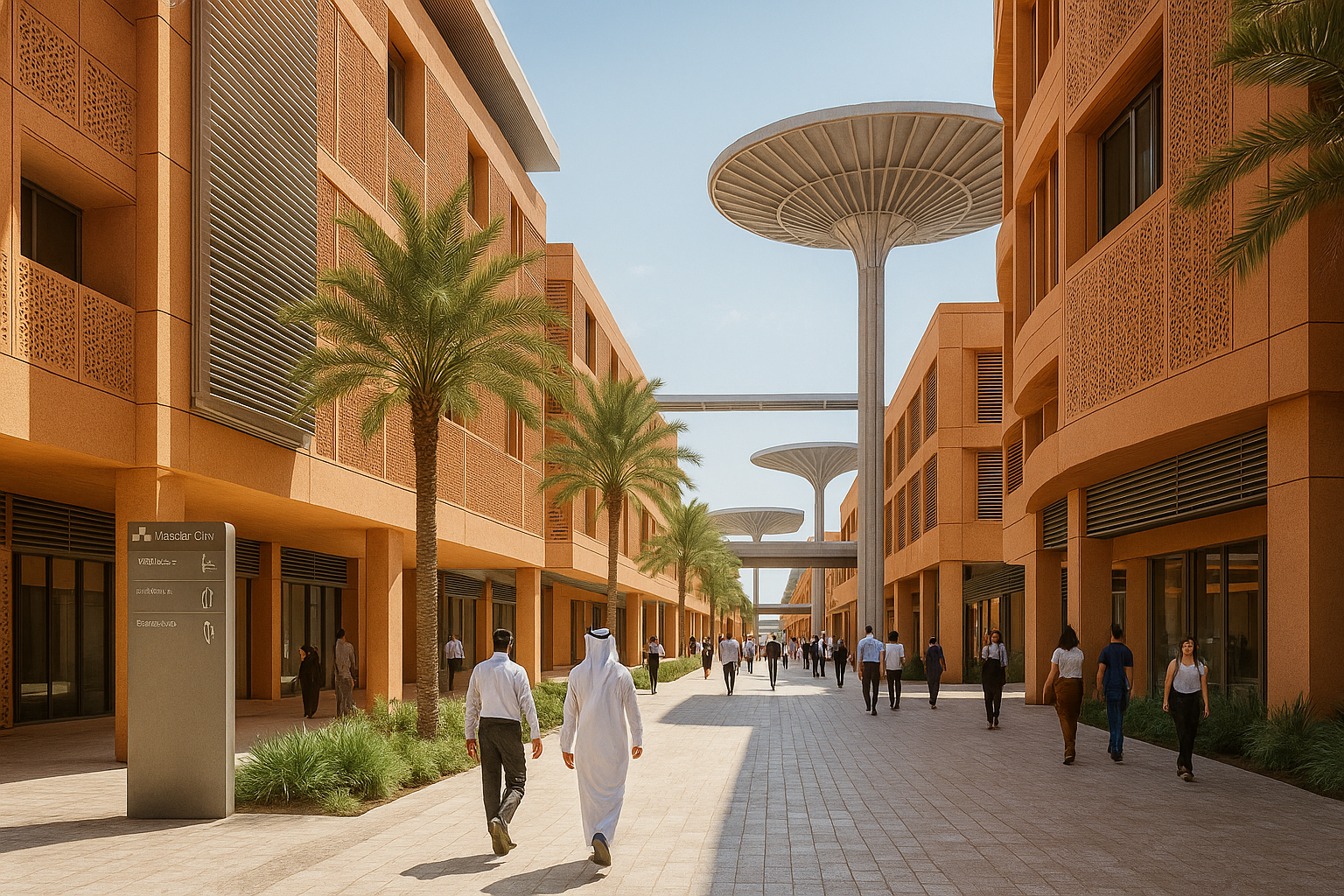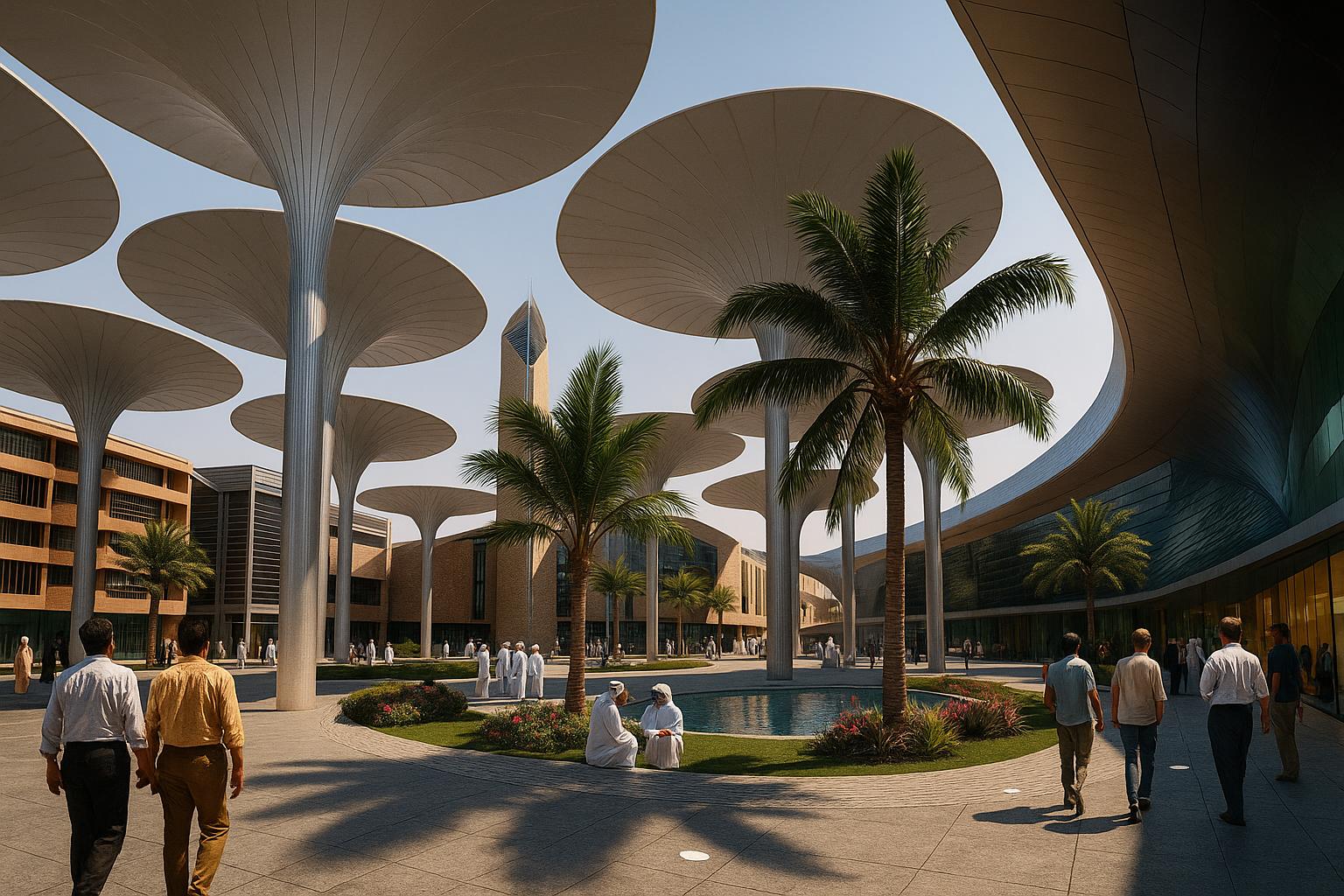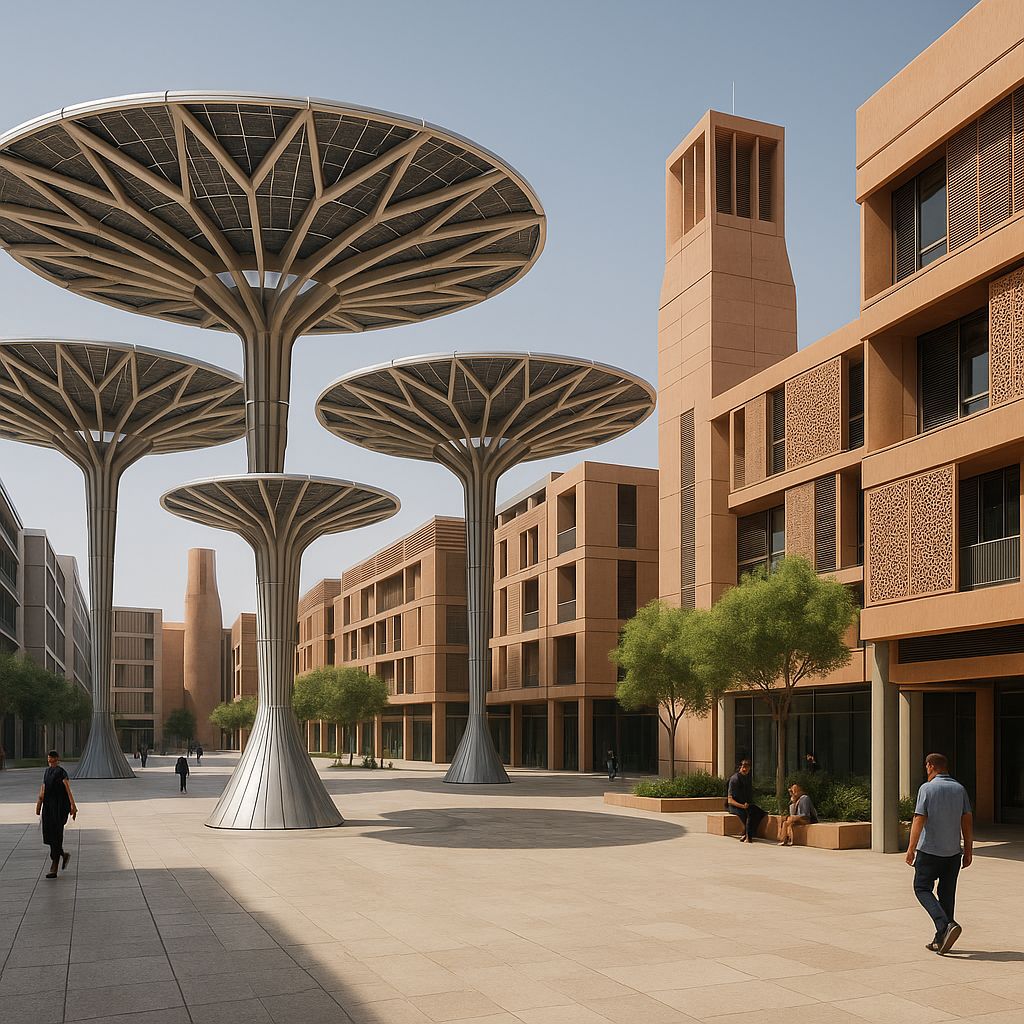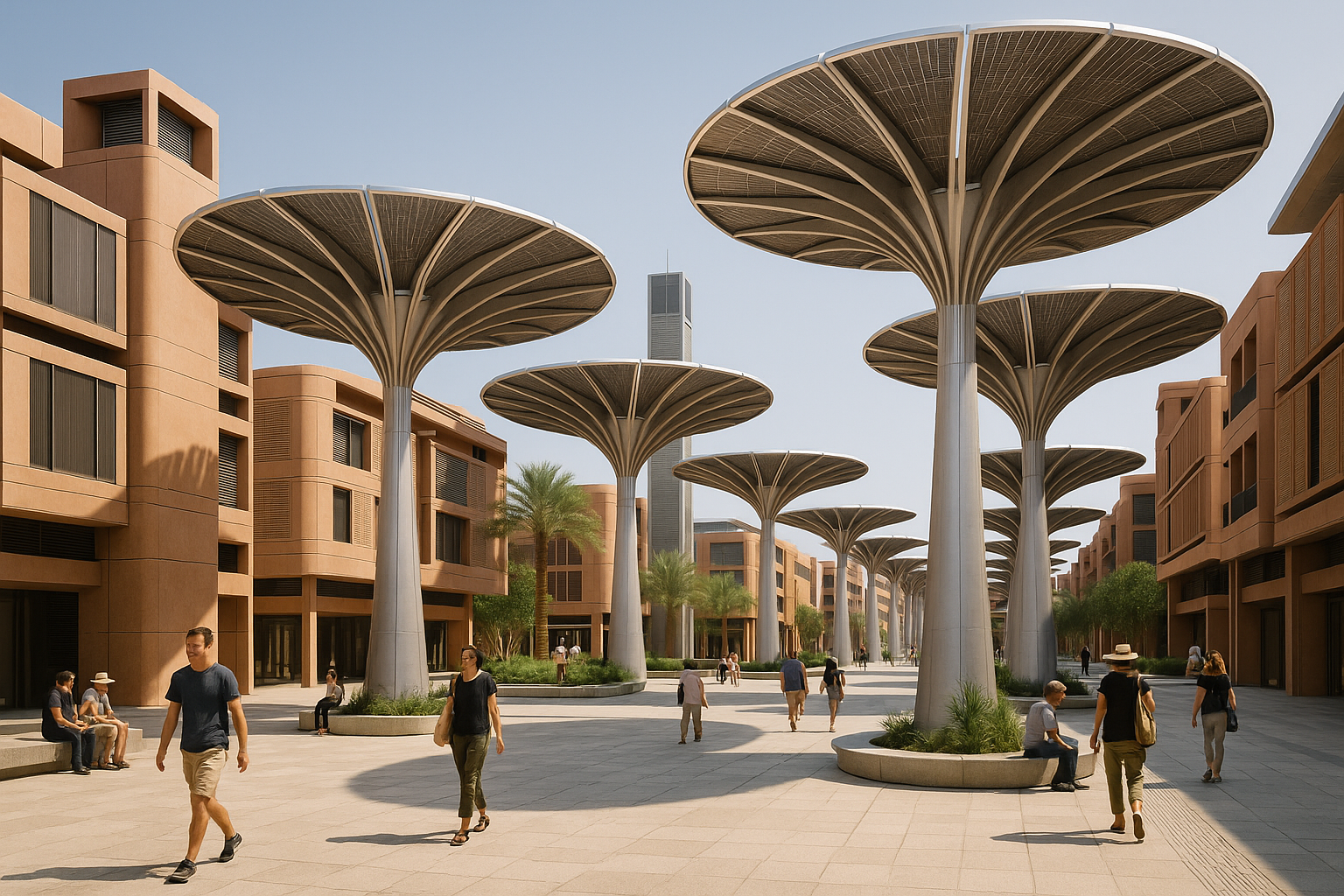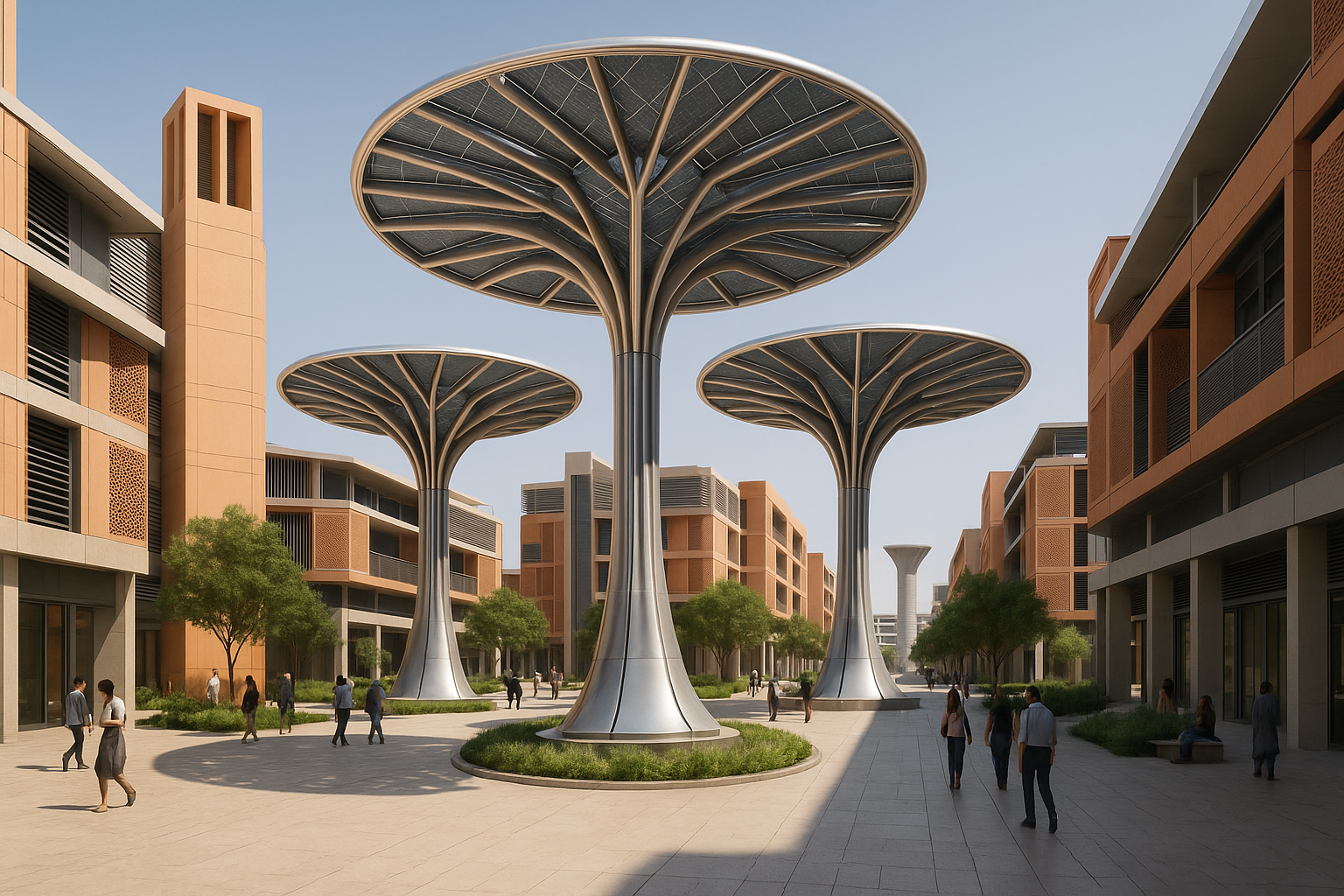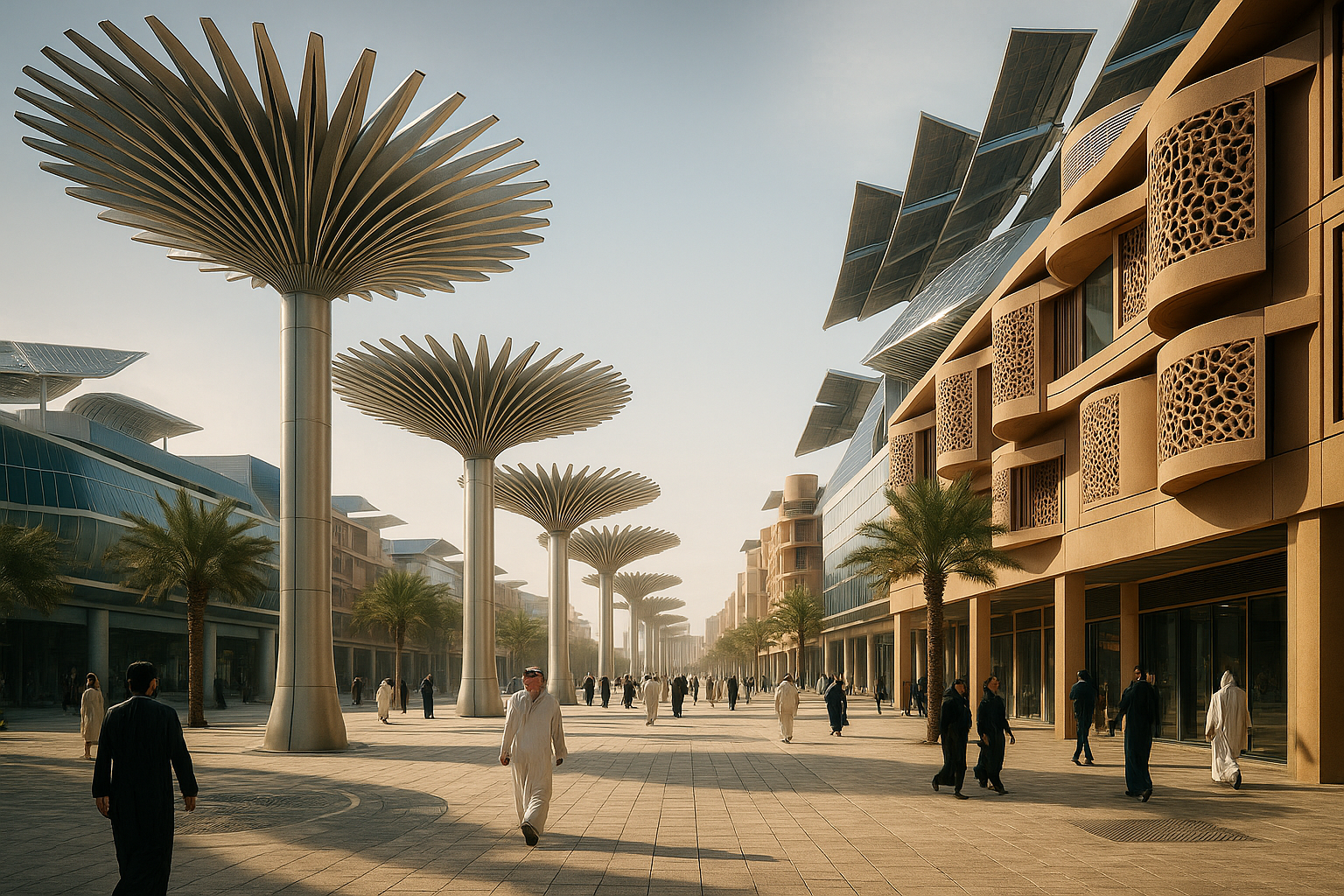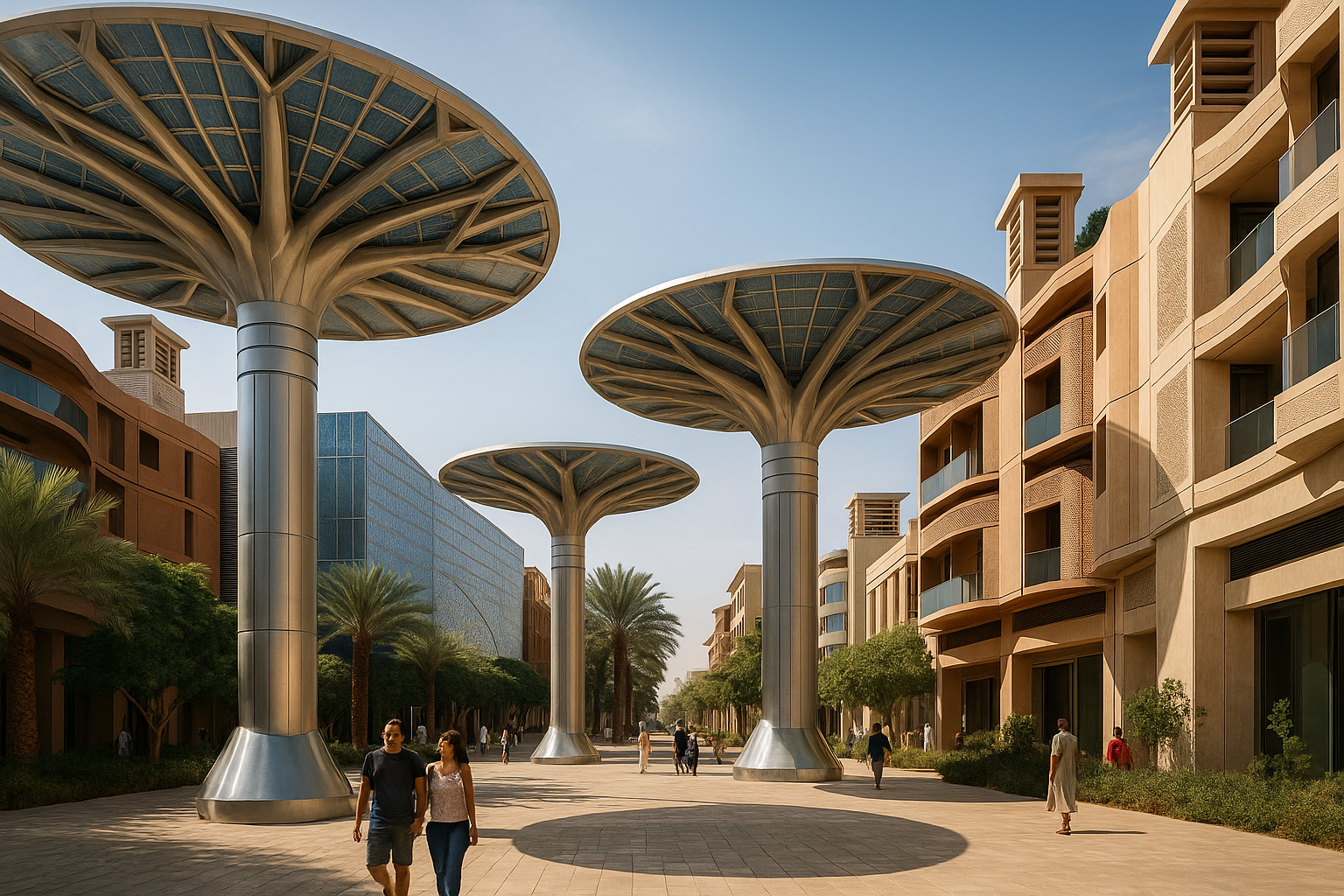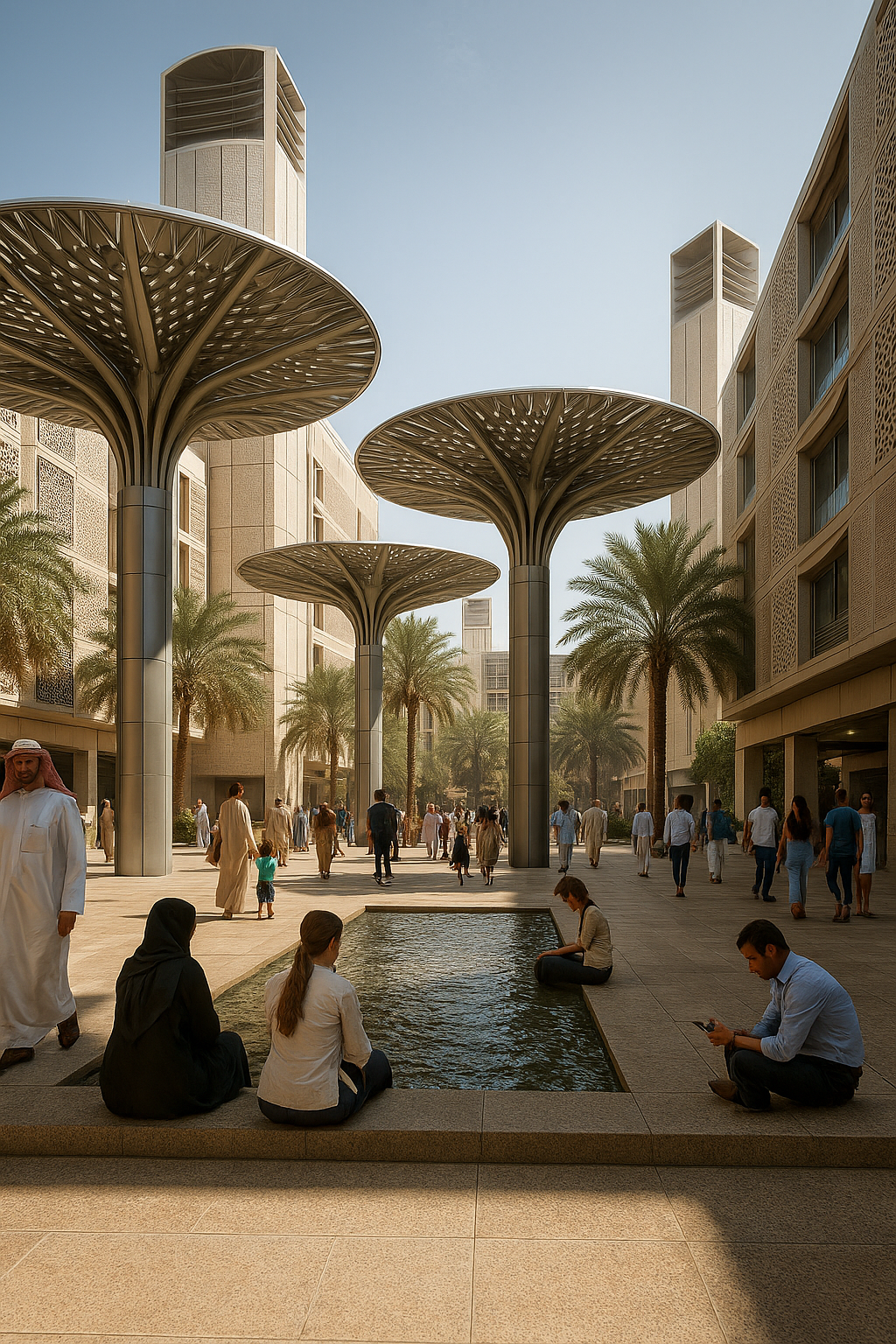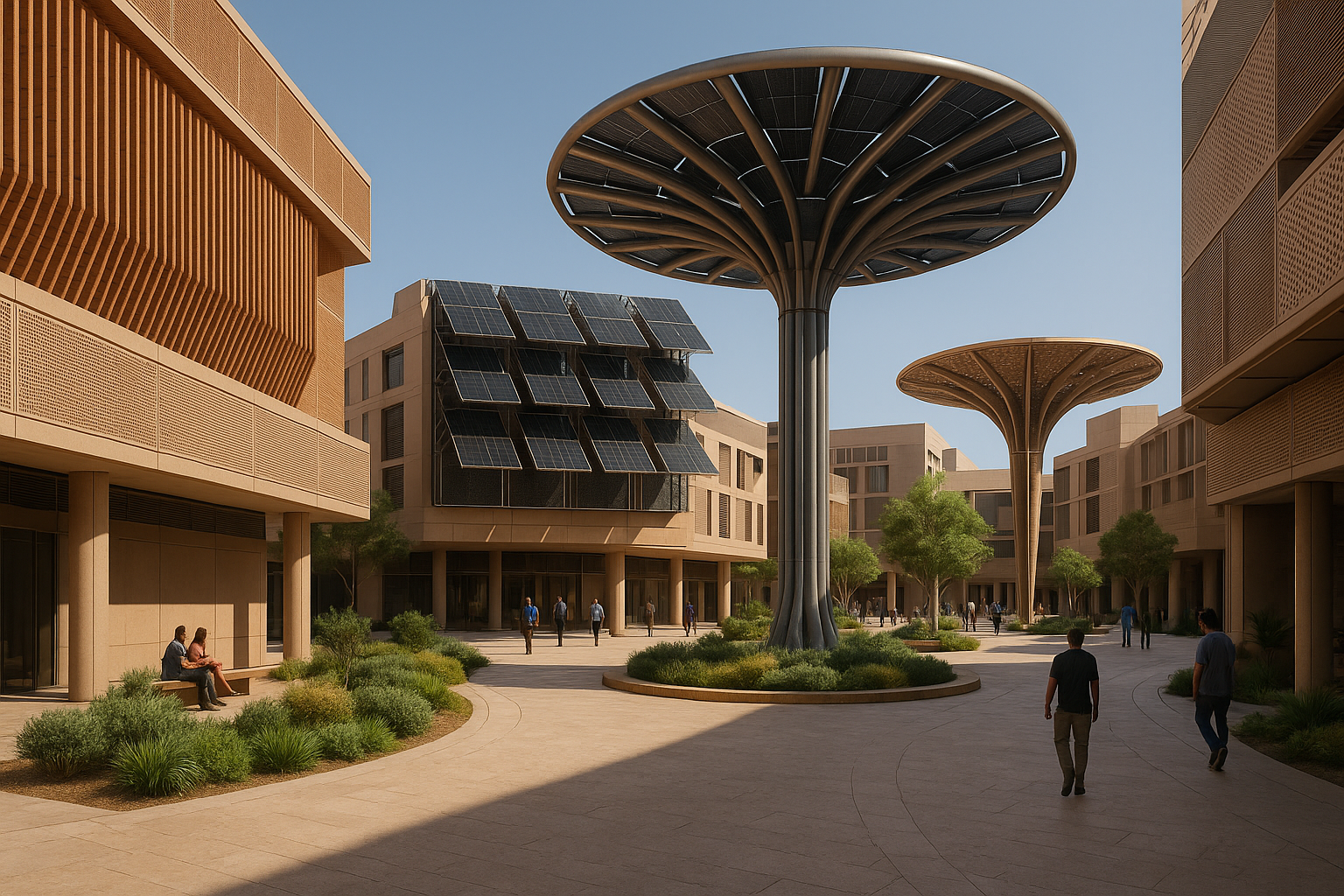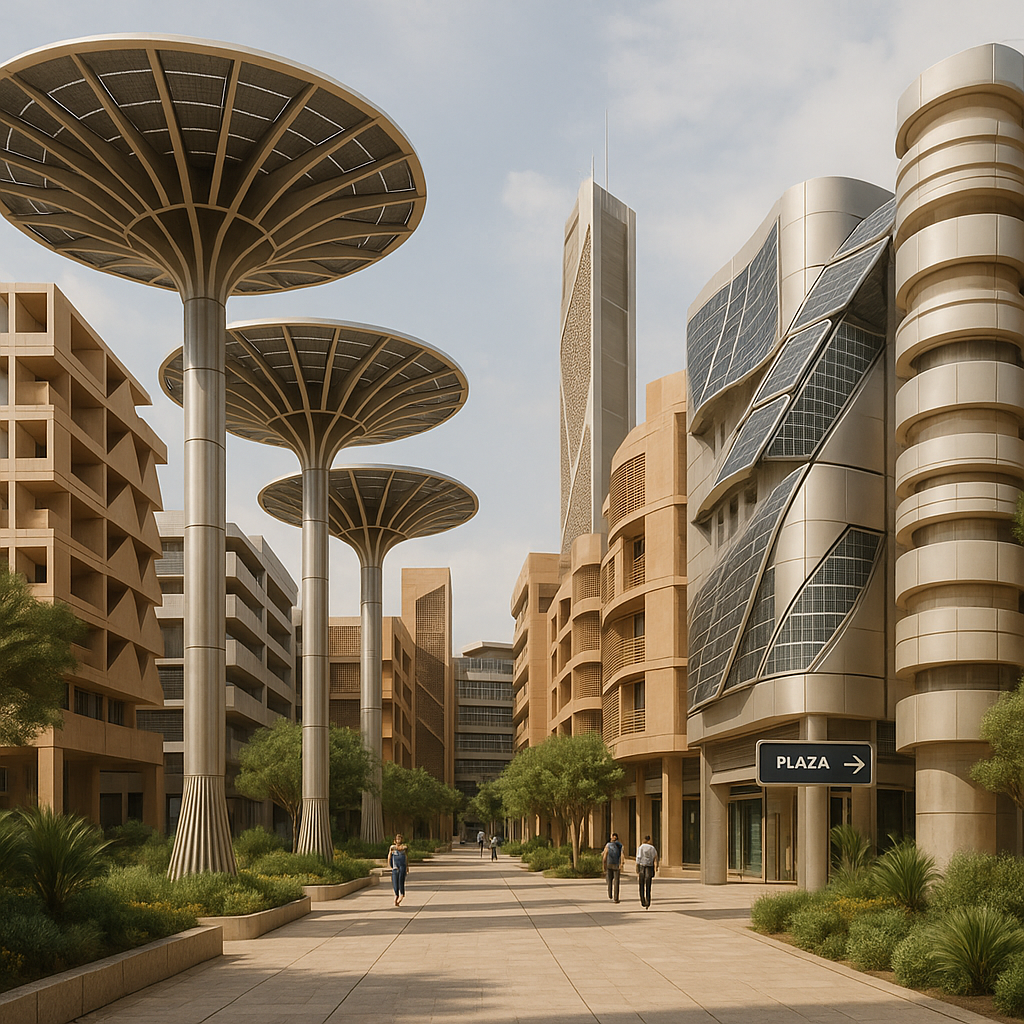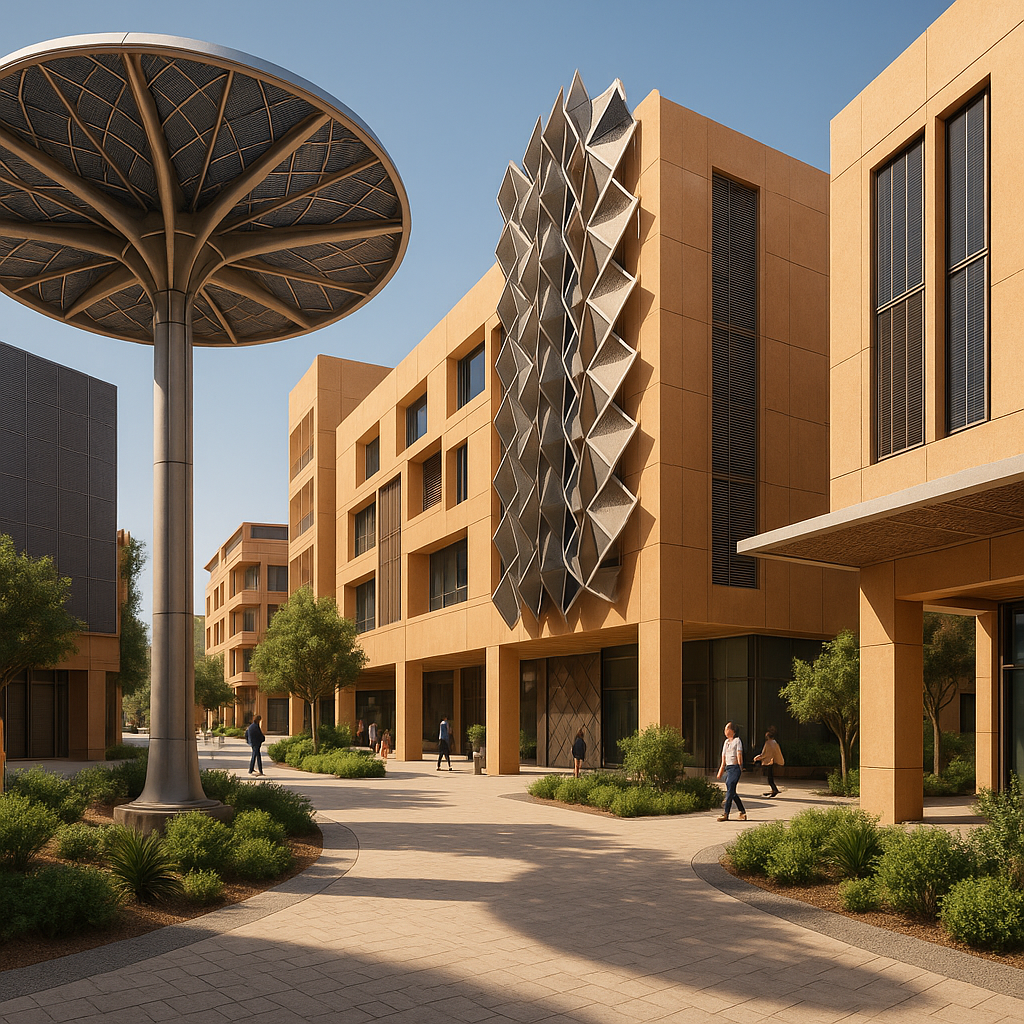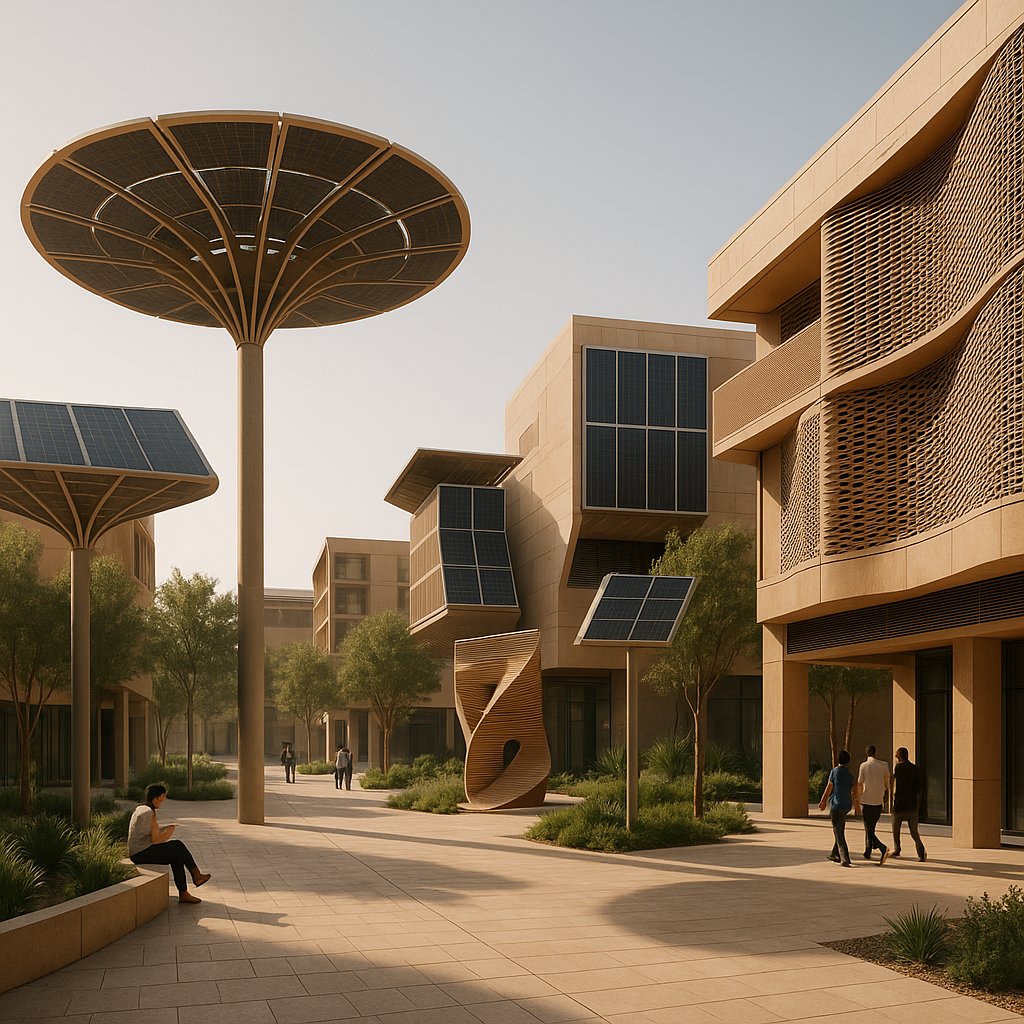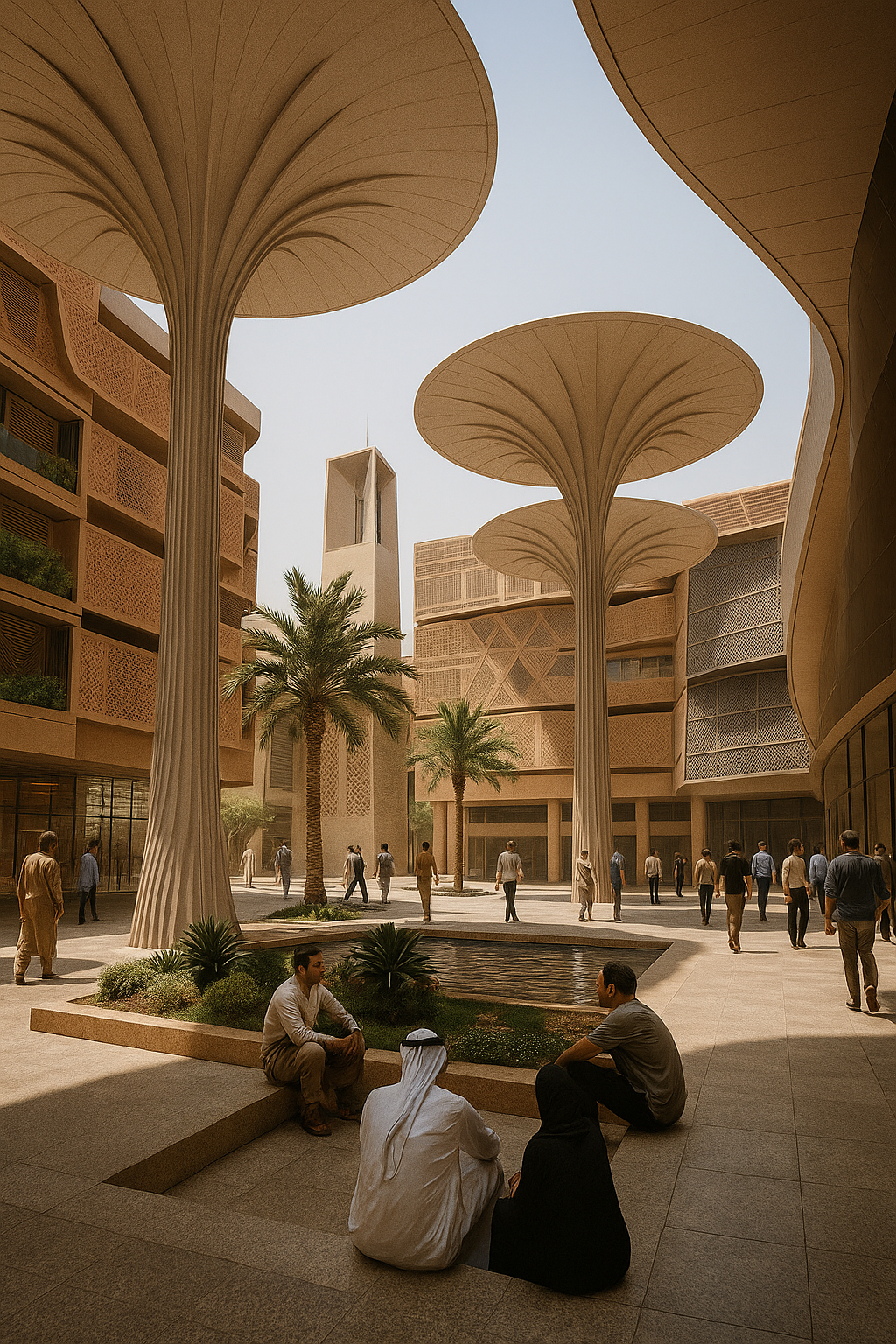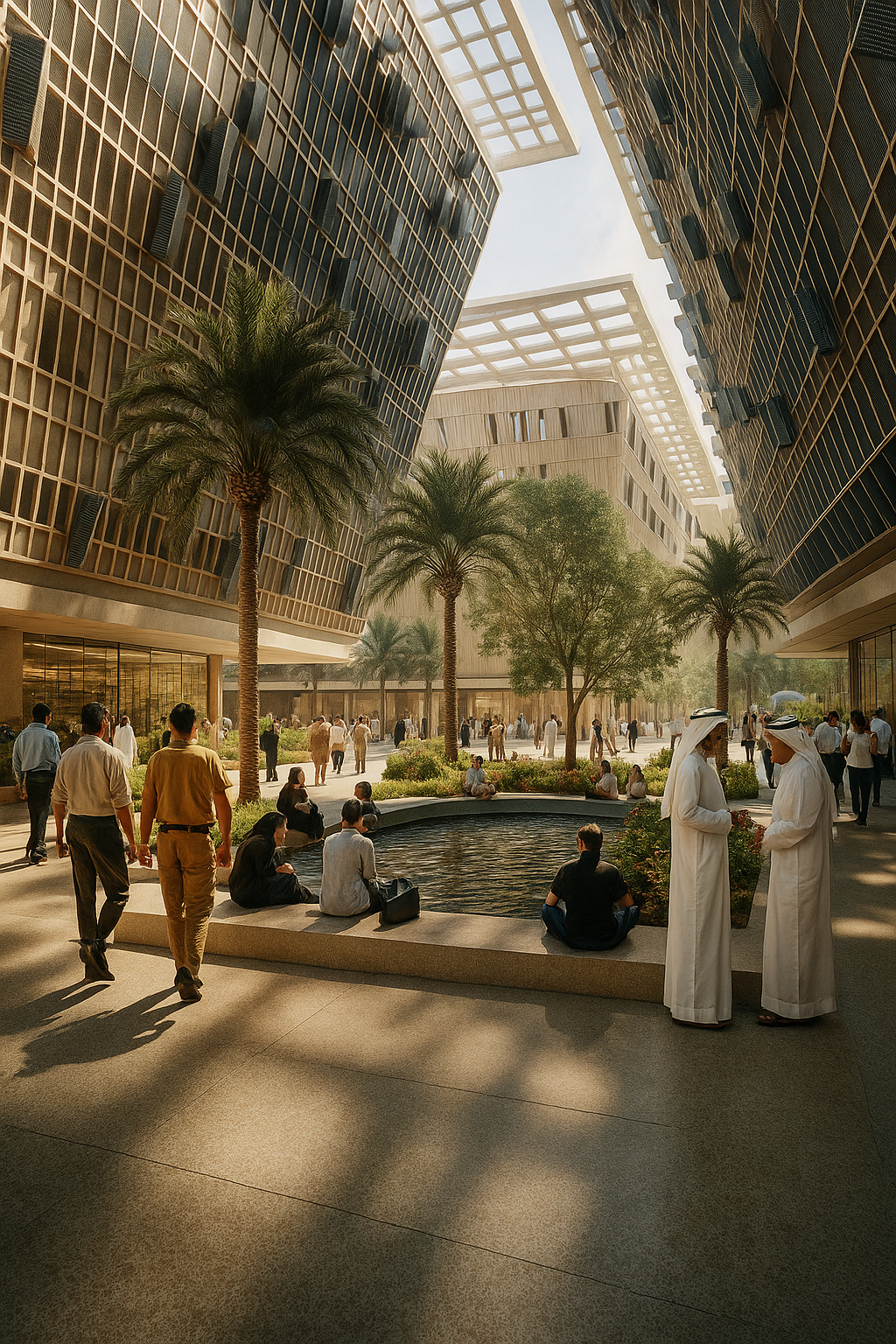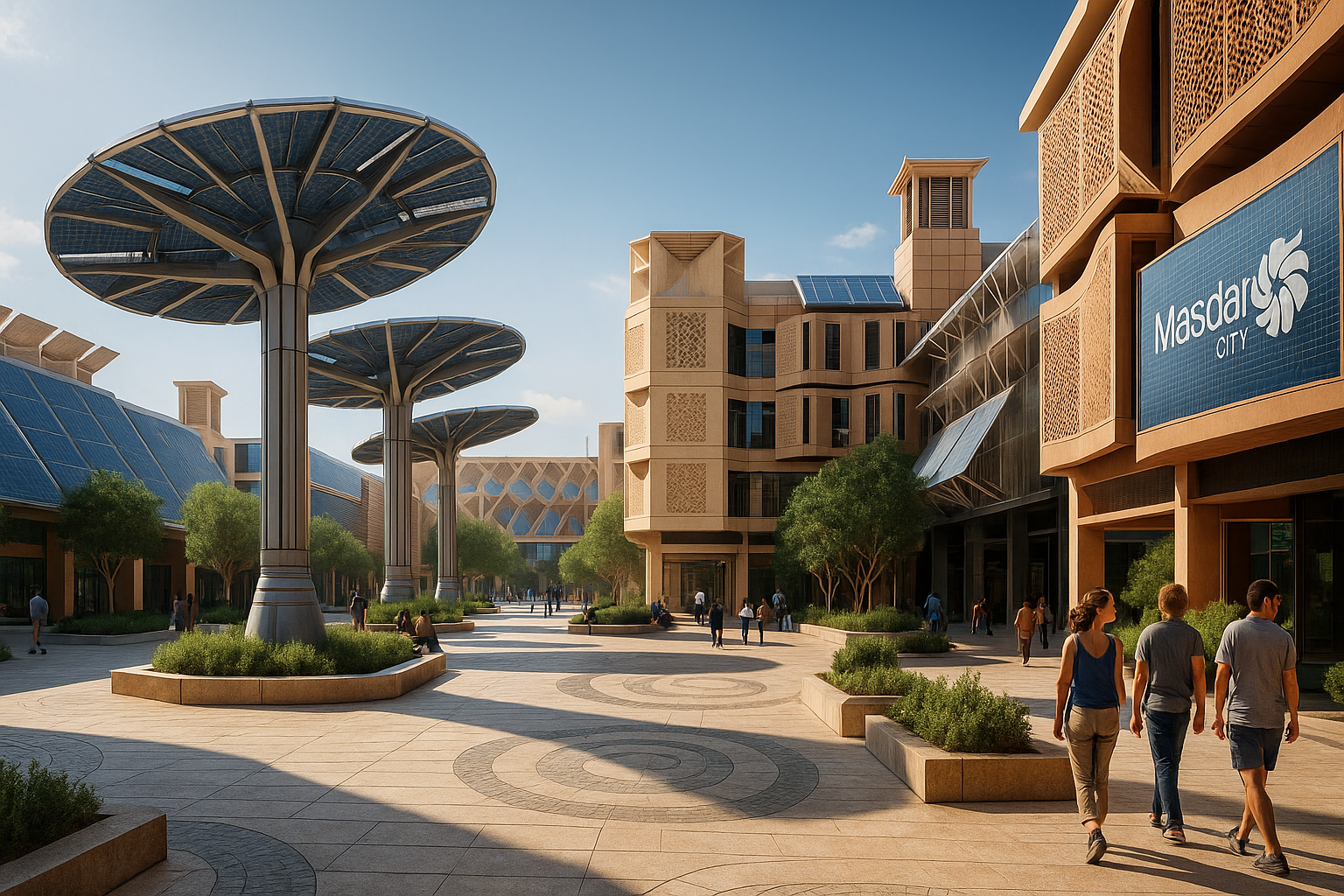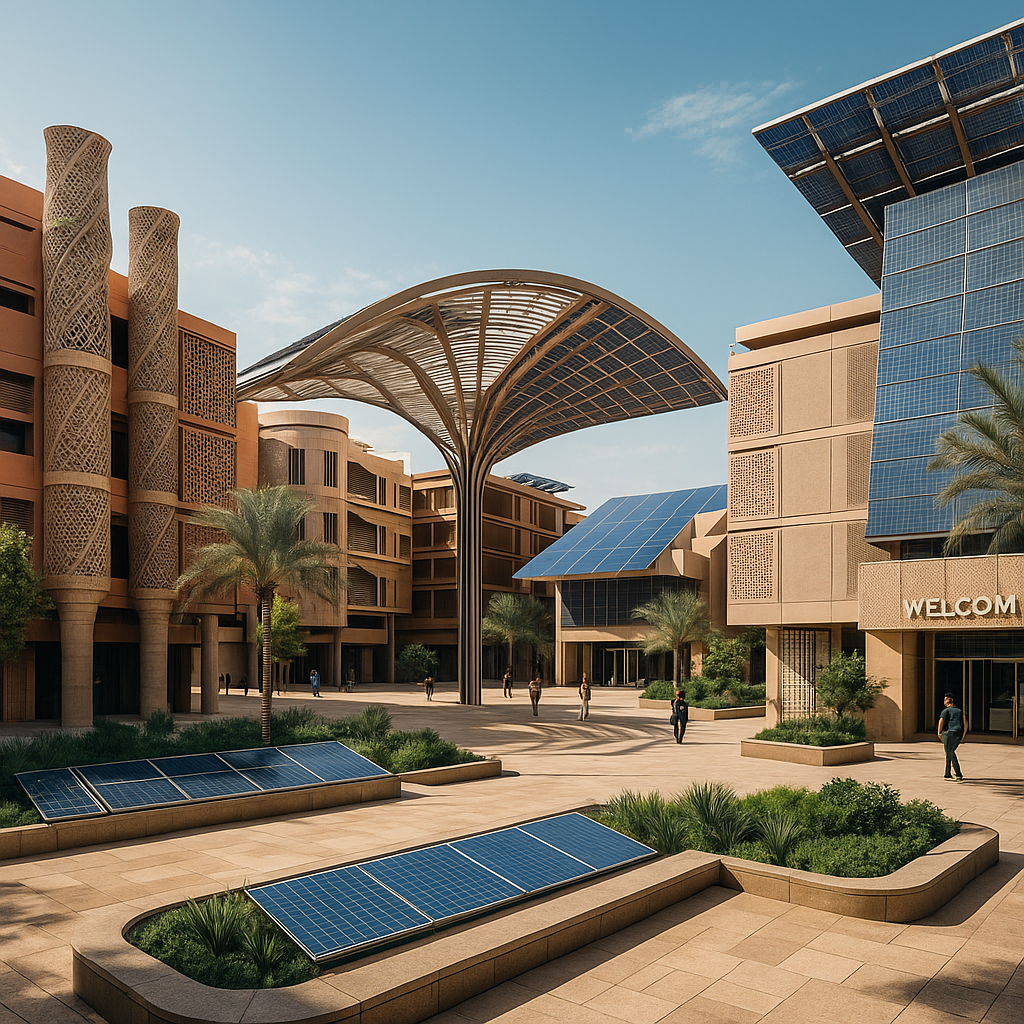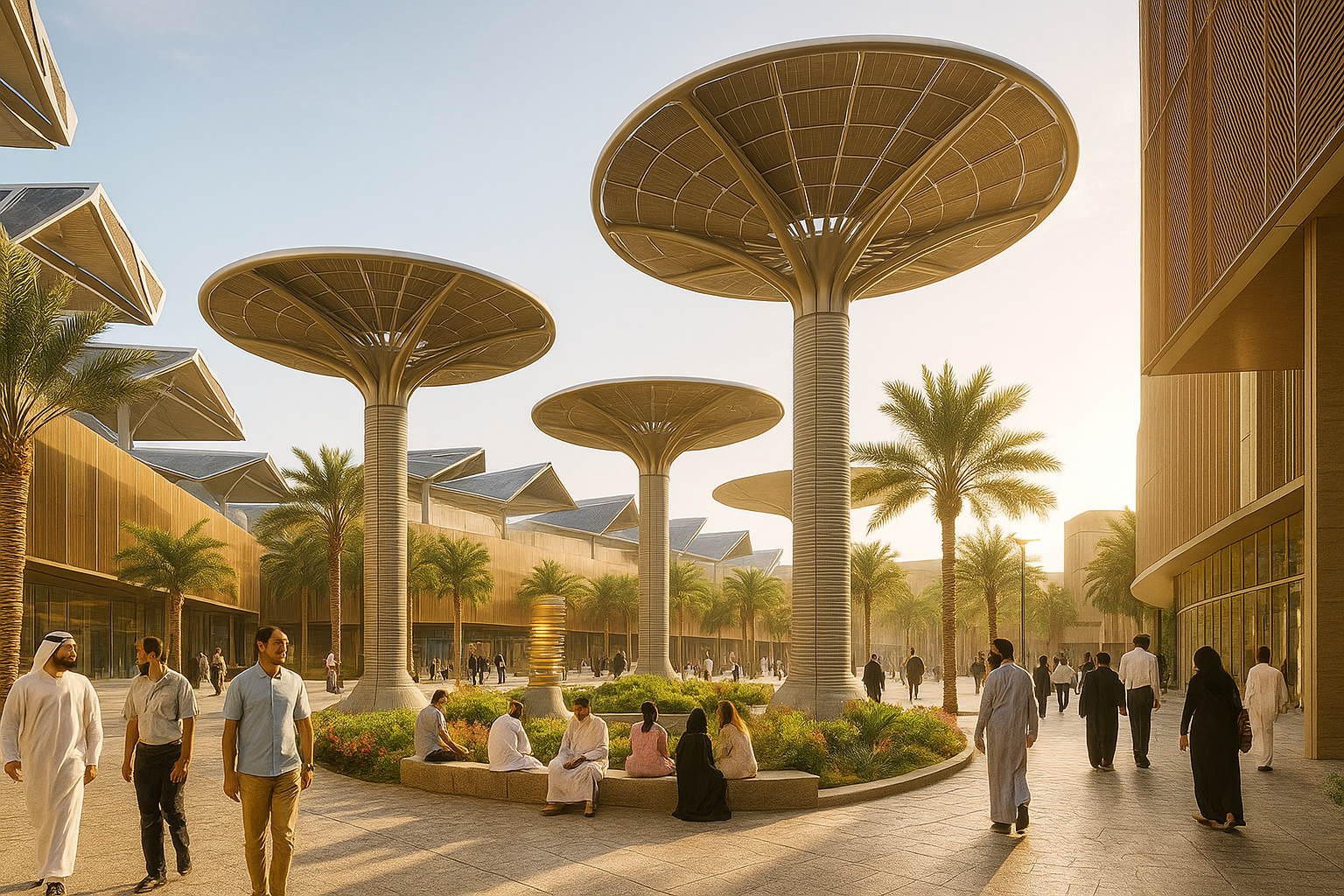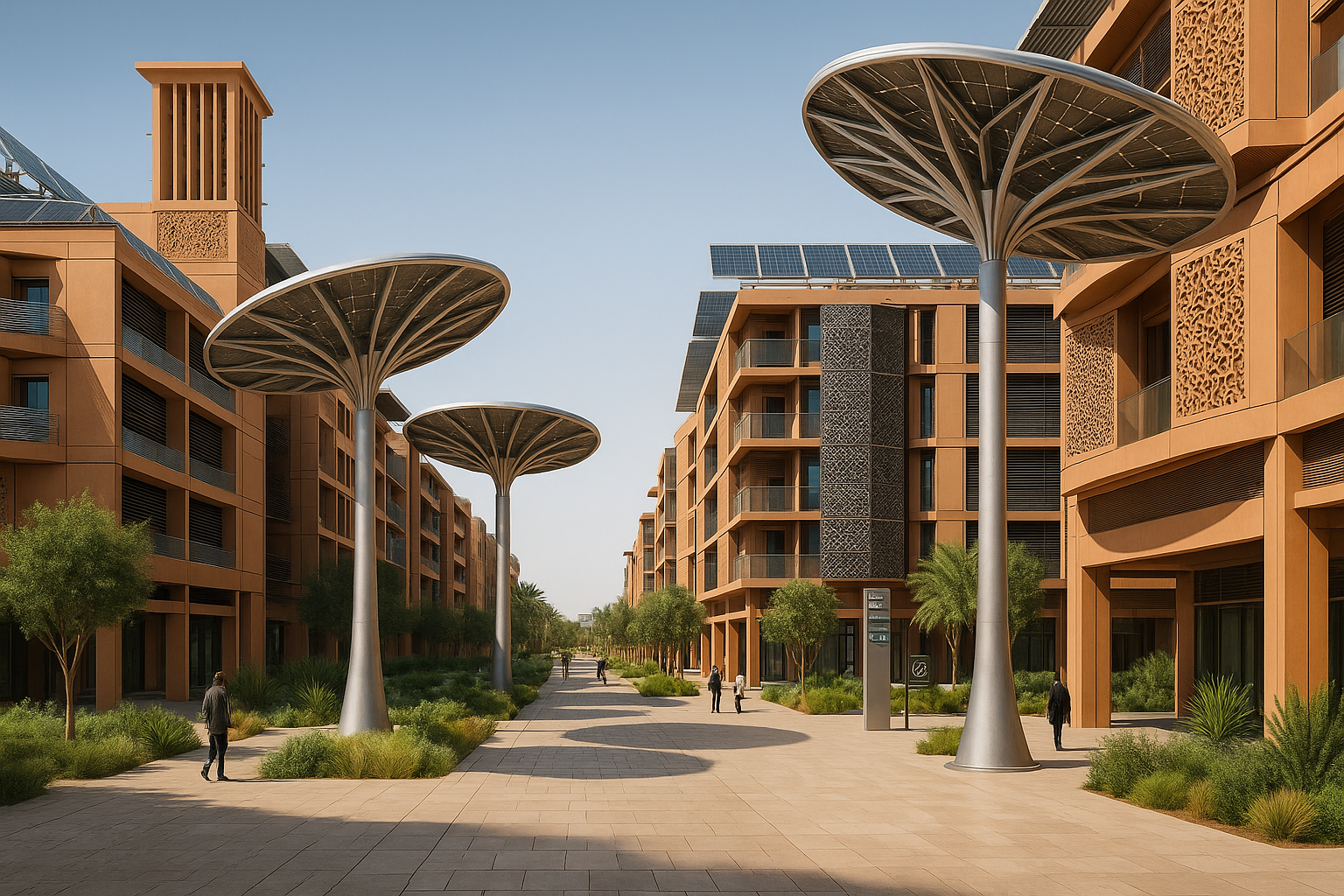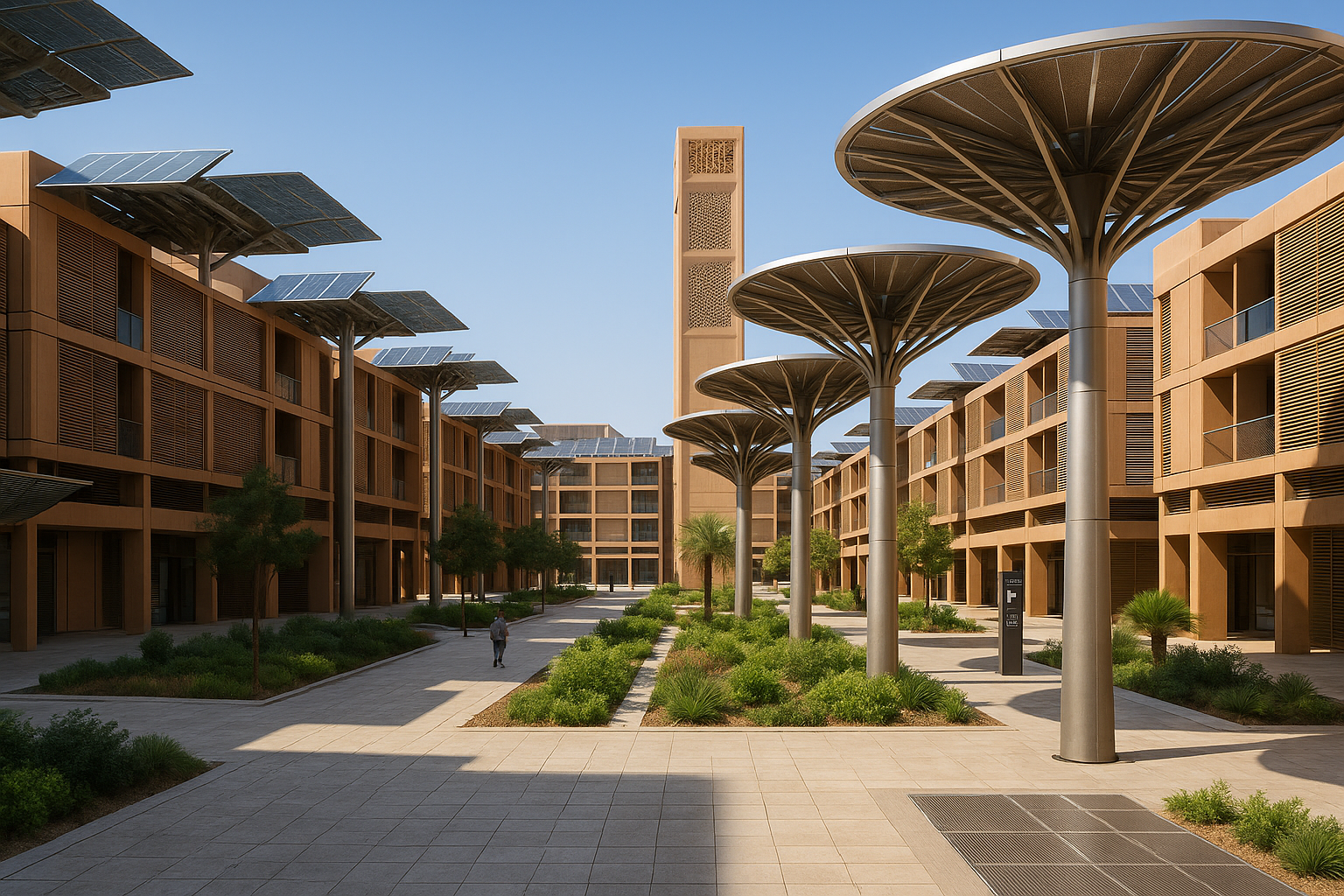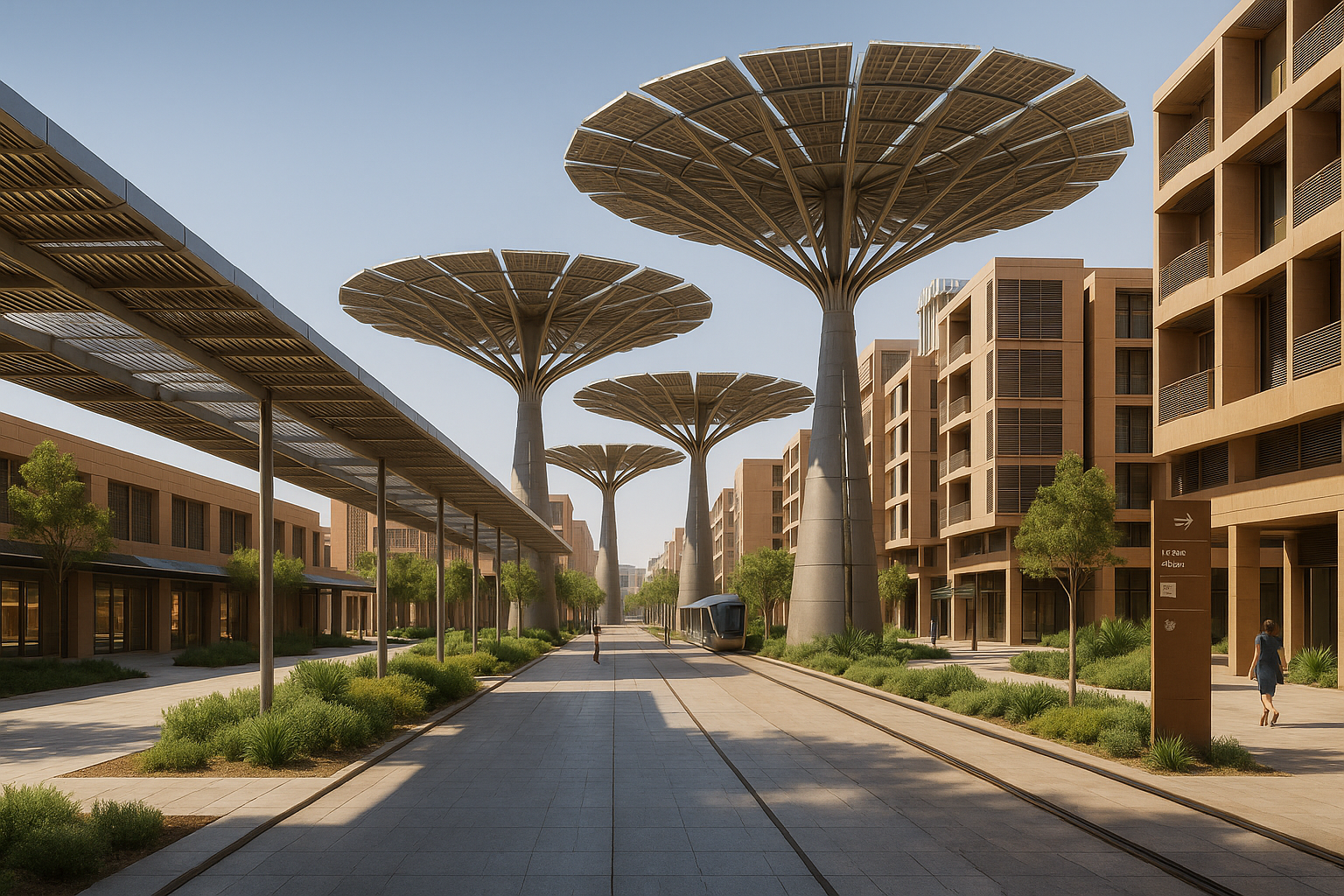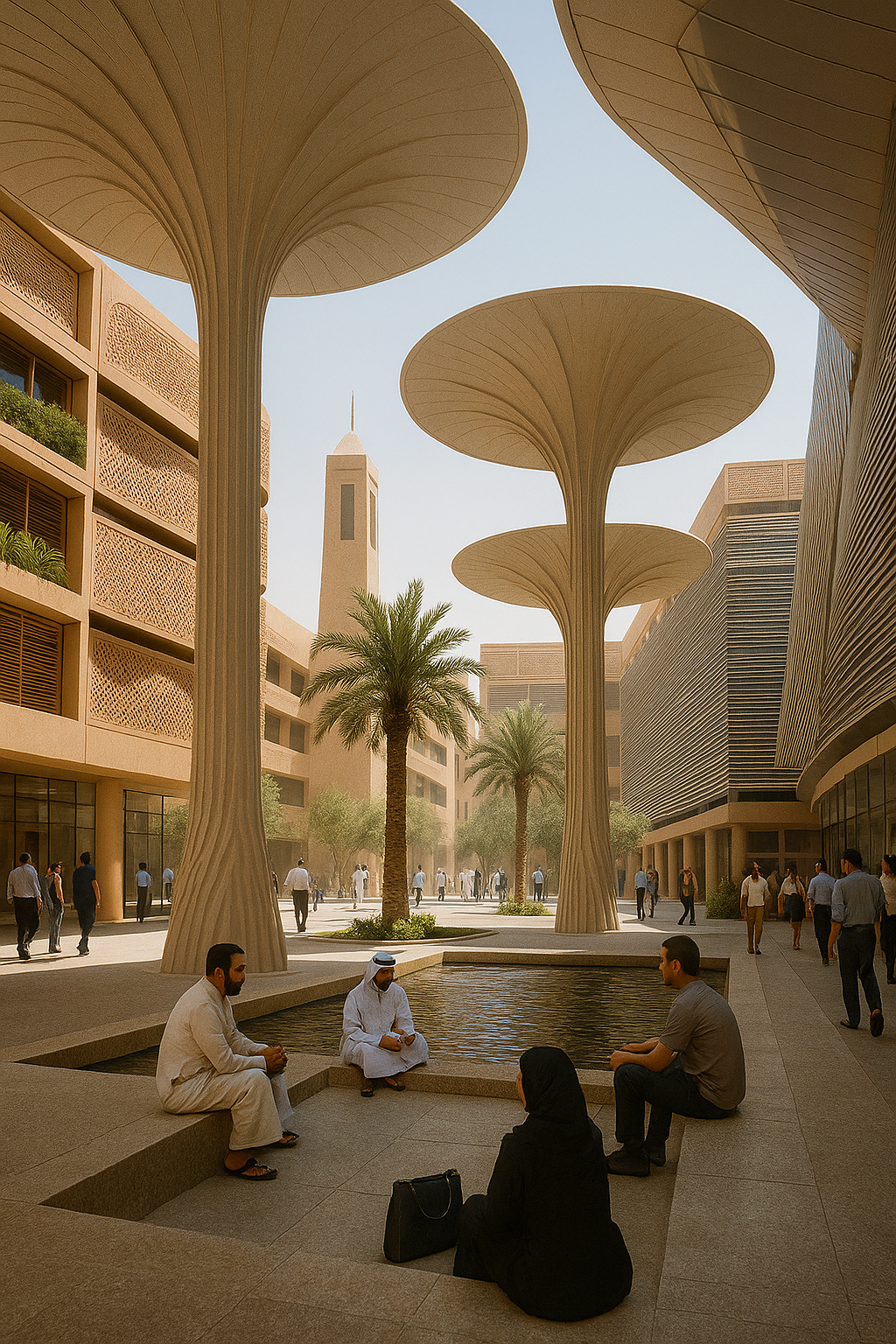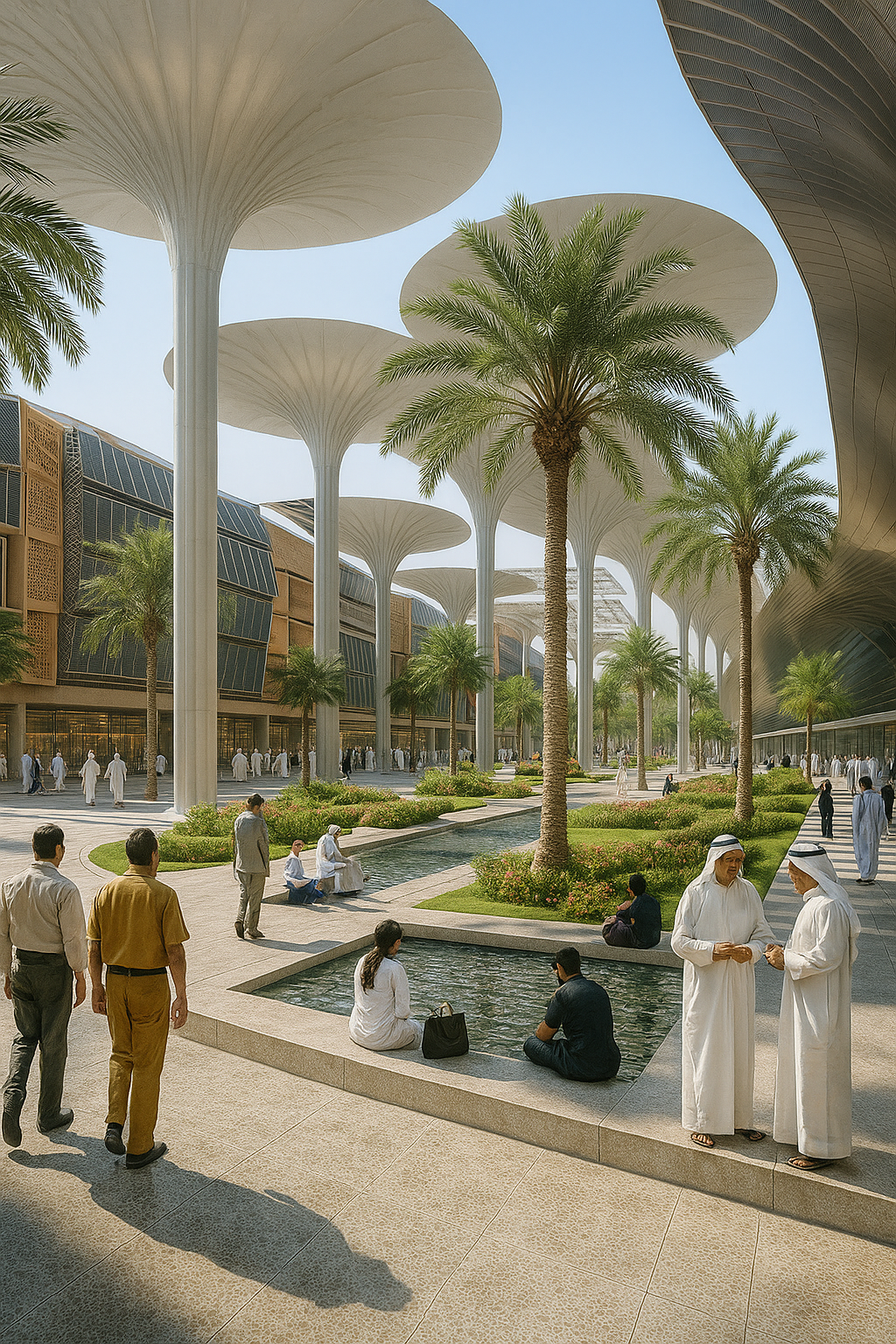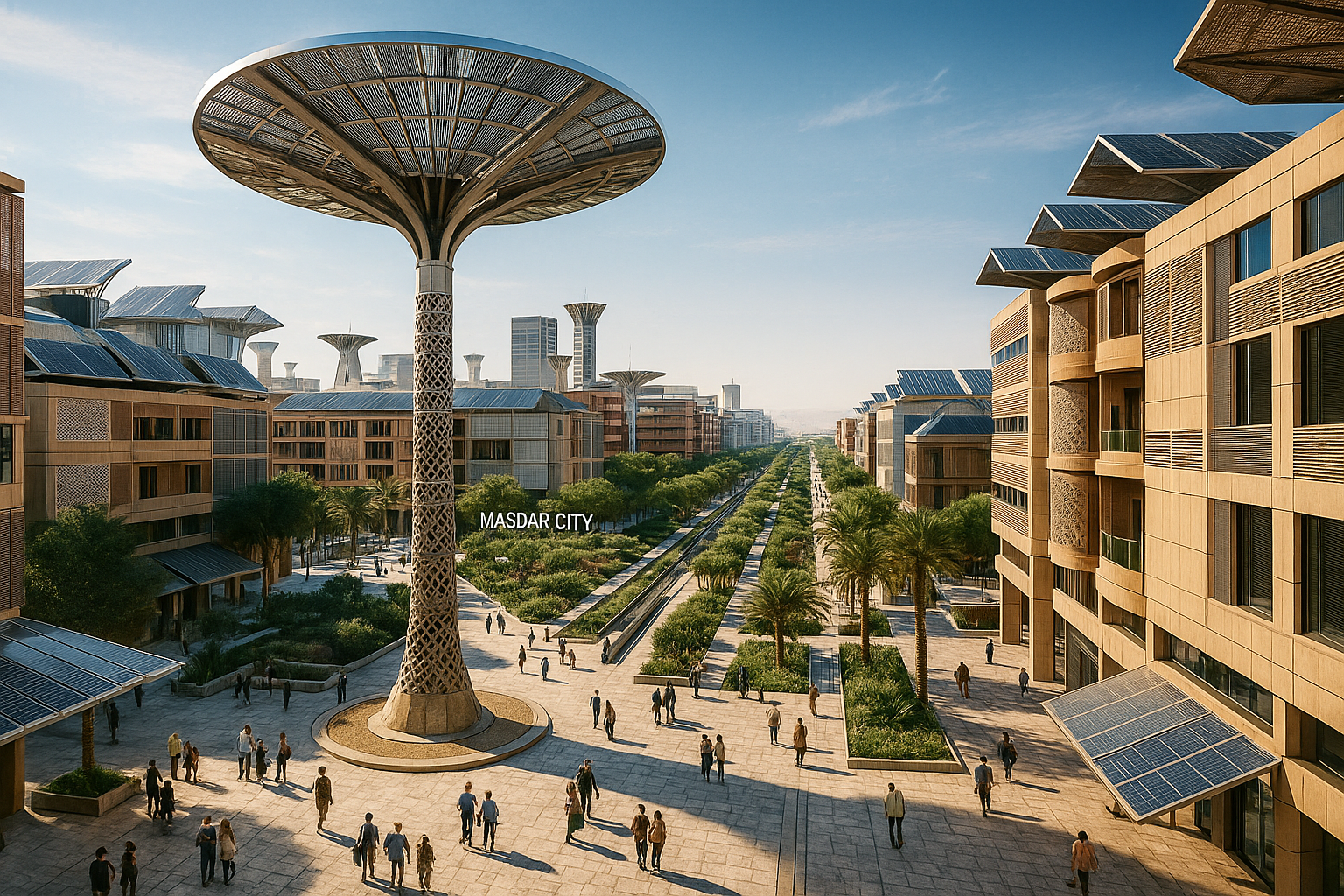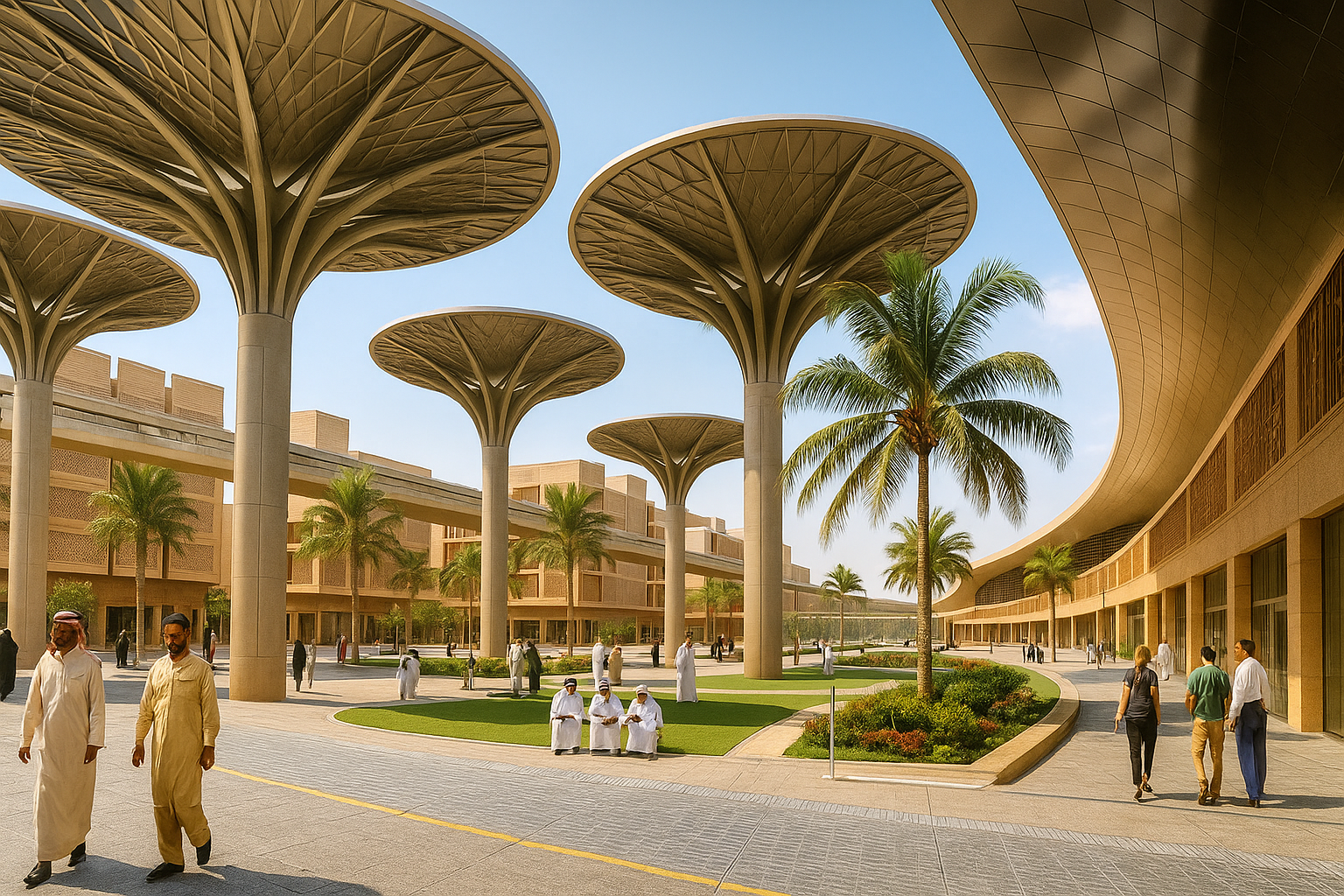Masdar city de Foster + parceiros
Principais características
Prompt positivo: Ultra-realistic 8K architectural visualization, eye-level perspective of Masdar City, the utopian vision conceived by Norman Foster in 2007. Located in the heart of the desert, the city integrates advanced environmental technologies with the aim of creating a radically sustainable community — one that emits zero carbon and wastes no natural resources.
The urban fabric is designed around high-performance sustainable systems. The city features solar thermal cooling infrastructure, iconic wind towers for passive ventilation, geothermal energy systems, and expansive solar farms situated on its perimeter, ensuring complete energy self-sufficiency.
Masdar City embodies a high-tech ecological ethos: streets are shaded, air is naturally cooled, and every element is calibrated for environmental efficiency. The architecture reflects a fusion of futuristic minimalism and traditional desert urbanism, with compact layouts, smart orientation, and modular material choices aimed at reducing heat gain and maximizing energy flow.
Rendered under crisp desert daylight with hyper-detailed textures — photovoltaic panel arrays, earthen-colored facades, high-albedo paving, brushed metal shading systems, ceramic louver screens, wind towers, and integrated sensor-based infrastructure — the image captures a technological oasis of sustainability, precision, and environmental harmony.
Prompt negativo: low resolution, post-apocalyptic ruins, gothic or baroque architecture, dark lighting, overgrown vegetation, fantasy aesthetics, curved organic shapes, historic buildings, colorful facades, steampunk or cyberpunk styles, night scene, retro-futurism, surreal forms, pollution, cluttered design.
Imagens produzidas pelo Chat GPT a partir de entradas de texto
Características formais
Prompt positivo: Ultra-realistic 8K architectural visualization, eye-level perspective of Masdar City, the utopian vision conceived by Norman Foster in 2007. Designed as a compact, highly sustainable urban model, the city is defined by a square footprint measuring 200 meters across. Its modular form reflects a core principle of scalability — Masdar City is not only located in the desert of Abu Dhabi but is also conceived as a prototype that can be replicated anywhere in the world.
The repetitive urban elements reinforce this replicability: solar-shaded pedestrian corridors, energy-efficient mid-rise buildings, modular infrastructure, and integrated transportation systems. The entire layout is optimized for minimal environmental impact, designed to be implemented in diverse geographic contexts while maintaining its carbon-neutral ethos.
Rendered under clean, natural desert light with hyper-detailed textures — sand-toned facades, solar panel arrays, geometric shading structures, reflective paving, aluminum louver systems, and smart environmental sensors — the image captures a compact, precise, and globally adaptable city. A vision of sustainable urbanism made portable through repetition, scale control, and design logic.
Prompt negativo: low resolution, chaotic layout, curved organic forms, fantasy environments, gothic or baroque details, steampunk or cyberpunk aesthetics, post-apocalyptic setting, vegetation overgrowth, colorful facades, soft romantic lighting, surreal shapes, night scenes, classical architecture, hand-drawn textures.
Imagens produzidas pelo Chat GPT a partir de entradas de texto
Características de Infraestrutura de Mobilidade
Prompt positivo: Ultra-realistic 8K architectural visualization, eye-level perspective of Masdar City, the utopian vision conceived by Norman Foster in 2007. The city is seamlessly connected to nearby communities and to the international airport through existing road networks and railway infrastructure. Designed as a model of compact, sustainable urbanism, Masdar City integrates high accessibility with regional mobility.
Within the city itself, a continuous linear park acts as a green spine, fostering pedestrian movement and ecological connectivity. The entire urban layout is planned around a maximum walking distance of 200 meters, encouraging both residents and visitors to move comfortably on foot. Shaded streets, compact urban blocks, and a hierarchy of pedestrian-first spaces shape the core experience of the city.
Rendered in crisp desert daylight with hyper-detailed materials — including clay-colored walls, textured solar screens, brushed aluminum shading systems, vegetated walkways, reflective paving, light rail elements, and smart signage — the scene captures a clean, technologically advanced, and human-scaled urban prototype. A city built for walking, rooted in environmental efficiency and intermodal connectivity.
Prompt negativo: low resolution, night scenes, dark lighting, fantasy architecture, post-apocalyptic ruins, cyberpunk or steampunk styles, curved organic forms, gothic or baroque ornamentation, vegetation overgrowth, chaotic street layout, colorful facades, surreal environments, soft focus, hand-drawn lines, classical architecture.
Imagens produzidas pelo Chat GPT a partir de entradas de texto
Características dos Espaços Verdes
Prompt positivo: Ultra-realistic 8K architectural visualization, eye-level perspective of Masdar City, the high-tech utopian vision conceived by Norman Foster in 2007. The city is meticulously designed around principles of environmental sustainability, energy efficiency, and carbon reduction. The scene captures a futuristic urban landscape where advanced green technology seamlessly interacts with communal spaces and their users.
Dominating the foreground are mechanized, biomimetic trees — innovative structures that respond to the rhythm of the day. During daylight hours, they unfold into wide, radial canopies, providing generous shade across the public plazas. At night, the trees close gradually, releasing the stored solar energy accumulated throughout the day, casting a soft ambient glow that illuminates the urban environment.
The materials are sleek and modern: brushed aluminum, solar glass, and ceramic panels, reflecting the city’s commitment to clean energy and intelligent design. The streetscape is pedestrian-oriented, with shaded walkways, integrated wind towers, and energy-harvesting surfaces. The overall atmosphere is serene yet technologically vibrant, rendered under diffused desert sunlight with crisp shadows and high-fidelity surface detail.
Inspired by Foster + Partners’ futuristic aesthetics and Middle Eastern vernacular architecture, the composition reflects a harmonious balance between tradition and innovation — a blueprint for climate-resilient cities of the future.
Prompt negativo: low resolution, anachronistic buildings, conventional city layouts, cars, cluttered compositions, poor lighting, exaggerated sci-fi elements, unrealistic textures, flat shadows.
Imagens produzidas pelo Chat GPT a partir de entradas de texto
Características Espaciais e Funcionais
Prompt positivo: Ultra-realistic 8K architectural visualization, eye-level perspective of Masdar City — the high-tech utopian vision imagined by Norman Foster in 2007. The scene portrays a cutting-edge urban environment where collective space is redefined through the seamless integration of sustainability and advanced technology.
Public plazas and communal zones are carefully designed to highlight sustainable innovation, drawing attention to eco-technological elements embedded within the architecture. Interactive structures, solar-responsive facades, and smart shading systems create a dynamic relationship between built form, environment, and human behavior. These spaces are not only energy-efficient but also socially engaging, fostering human interaction, collaboration, and community life.
Materials include matte-finish solar panels, sand-toned composites, and recycled urban textures, all bathed in warm, diffused daylight under a clear desert sky. Pedestrian pathways wind through lush, curated vegetation and shaded alcoves, with kinetic installations that adapt to environmental changes. The city pulses with a quiet intelligence — an elegant harmony of engineering and ecology.
Inspired by Foster + Partners’ minimalist futurism and contextual sensitivity to Middle Eastern climate and culture, the image captures a bold vision of urban sustainability where human connection and technological progress coexist.
Prompt negativo: low resolution, generic cityscape, outdated materials, cars, dark or cluttered compositions, exaggerated sci-fi, unnatural lighting, lack of human scale, poor texture detailing.
Imagens produzidas pelo Chat GPT a partir de entradas de texto
Todos os prompts anteriores.
Prompt positivo: Ultra-realistic 8K architectural visualization, eye-level perspective of Masdar City — the high-tech utopian prototype envisioned by Norman Foster in 2007. Located in the heart of the Abu Dhabi desert, the city is meticulously designed to embody radical environmental sustainability, zero carbon emissions, and zero waste. Its compact 200-meter-wide modular grid is conceived not only as a local solution but as a globally replicable urban model.
The urban fabric is structured around high-performance ecological systems: solar thermal cooling infrastructure, iconic wind towers for passive ventilation, geothermal energy networks, and vast solar farms along the city’s perimeter — enabling full energy self-sufficiency. A continuous linear park threads through the city as a green spine, supporting ecological connectivity and walkable urban mobility, while shaded pedestrian corridors and integrated public transport reinforce the compactness and intermodality of the master plan.
Architecture blends futuristic minimalism with vernacular desert urbanism — compact blocks, intelligent orientation, and modular material choices are calibrated to minimize heat gain and maximize environmental efficiency. Streets are lined with responsive systems: kinetic shading canopies, brushed metal sunbreakers, aluminum louvered screens, and high-albedo paving.
In the foreground, biomimetic mechanical trees unfold broad radial canopies during the day, casting deep shade across civic plazas; at night, they close gently, emitting stored solar energy as ambient light, turning the cityscape into a luminous oasis. Facades feature sand-toned ceramic panels, solar glass surfaces, and sensor-integrated skins. Vegetated pathways, reflective stone pavement, and signage informed by AI-driven environmental data enhance walkability and livability.
The atmosphere is serene yet technologically vibrant — a city rendered in crisp desert sunlight with hyper-detailed textures, fine architectural grain, and a striking harmony between ecology, innovation, and human-centered design. Inspired by the futuristic ethos of Foster + Partners and rooted in Middle Eastern climatic traditions, this visualization captures a resilient urban model where precision, repetition, and scalable design logic define the blueprint for a portable, sustainable future.
Prompt negativo: low resolution, generic urban scenes, heavy traffic, cars, outdated infrastructure, sci-fi exaggerations, poorly lit environments, unrealistic proportions, flat materials, cluttered compositions, lack of ecological detail, inconsistent architectural language.
Imagens produzidas pelo Chat GPT a partir de entradas de texto
